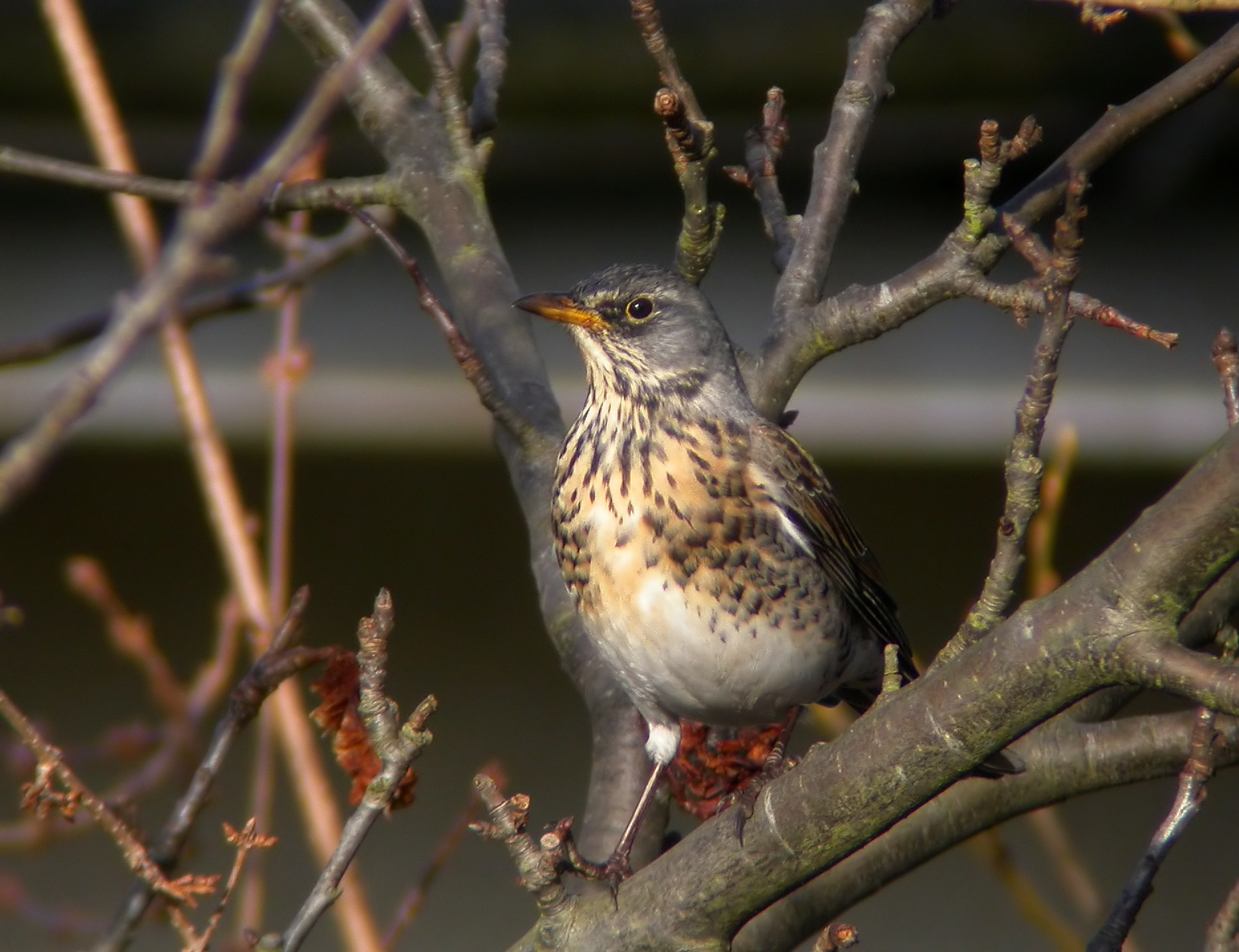Friday 30th March - Ray Baker
I just went for a little walk around the reserve mid-morning today and was rewarded by my first sighting of a new butterfly species for the year - a Comma. This is a medium sized orange and brown butterfly and is named after the comma-shaped mark which stands out on an otherwise dark underwing. The easiest field-mark though is the shape of the wings - which look a bit like a ragged leaf - and is unique to this species.
Not too much happening on the bird-front.... Greenfinches continue to sing noisily (if you can call their screeching 'singing') and we seem to have several males based in and around the reserve, which is good, and I have noticed that we seem to have been found wanting by the Green Woodpeckers - they had a good look around the reserve a week or so ago, but I havn't seen or heard them since - they are still in the area, as you can hear them yaffling a bit further away but it looks as if they didn't find any habitat on the reserve that they liked. We do seem to have a lot of Jays though... more than you would have thought our little reserve would support - just wait and see what develops I guess.
I did hear what I thought was a Green Woodpecker when in the garden yesterday, but it didn't sound quite right, and I wasn't completely surprised to find that it was actually a Starling, a species which has turned mimicry into an art-form! Those of you of a certain age may remember the Trim-phone - which was just about the first phone to use an electronic ringtone rather than a bell - and (you've guessed!) the Starlings around my house used to do a perfect impersonation.... almost as if they enjoyed the sight of me running back to the house to answer the phantom 'phone-call'! The bird equivalent of Knock-down Ginger!
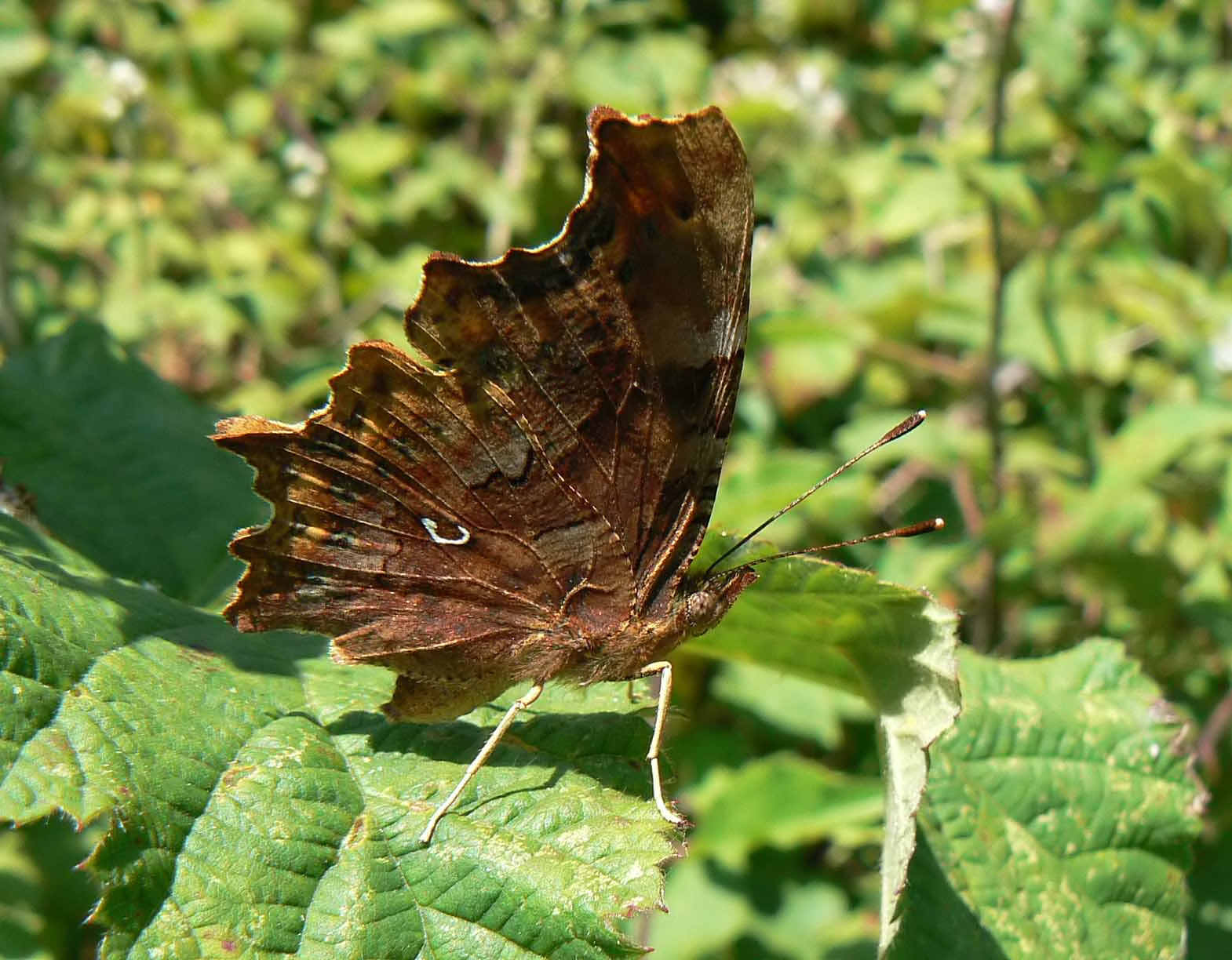
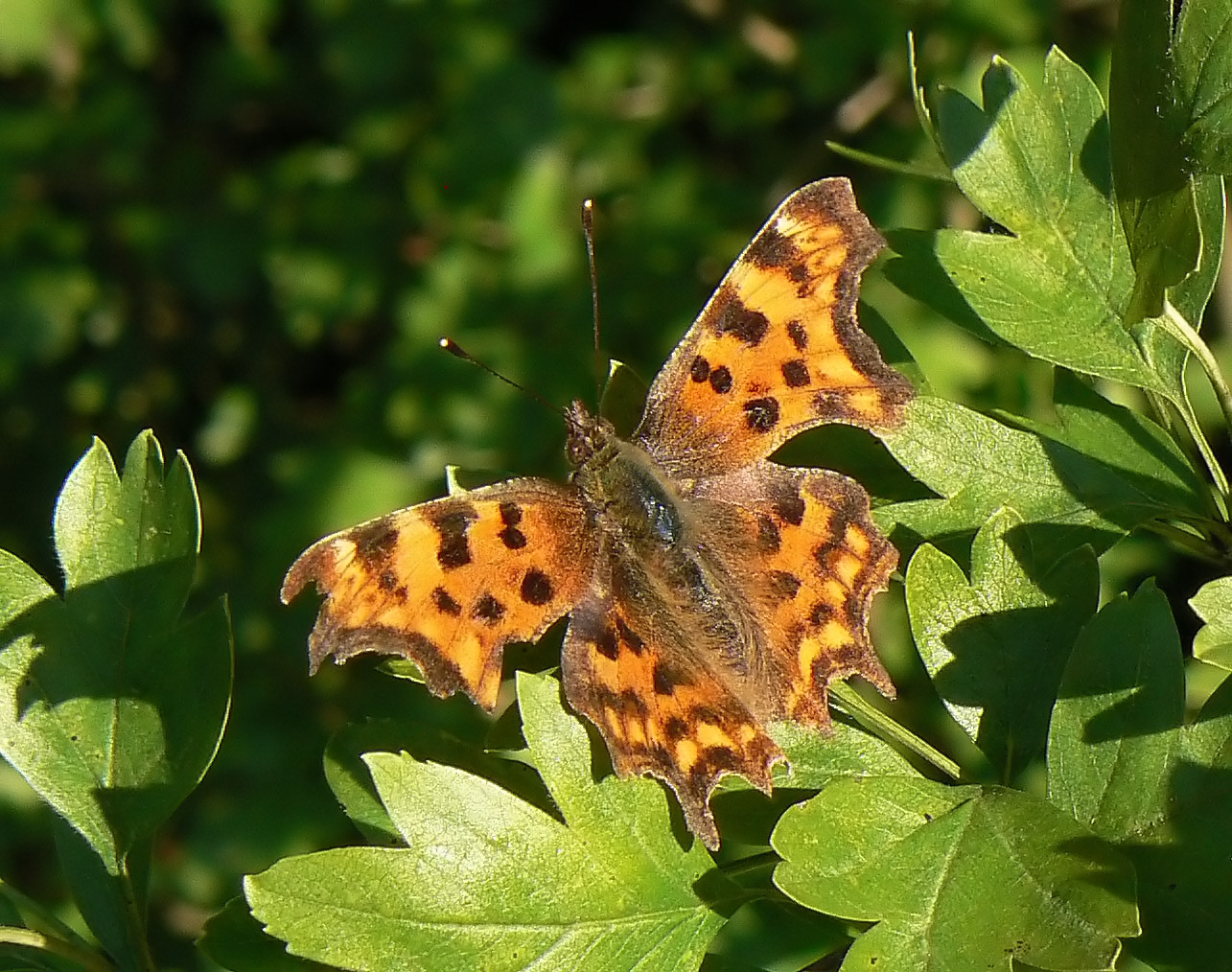
Wednesday 28th March - Ray Baker
I went for a long-ish walk around the local area today (more later!) and so didn't get into the reserve until about 11:30, but there were still a few things to be seen. When taking some photographs of shrubs in the butterfly garden I saw 2 butterflies - a Holly Blue and a Small White, and also my second sighting (saw one yesterday too) of a mystery creature around the meadows - it appeared to be a small brown butterfly with a very fluttery flight.... Only slight problem being that I can't off-hand think of anything that matches the description that is actually flying at the moment. I'll do a bit of research and hopefully come up with an answer - these things have a way of getting solved...although sometimes it's years later!
I saw a female Blackcap by Coldharbour Copse and a male singing from a tree in the gardens just behind the pond, and it appears that we have at least 2 pairs of Long-tailed Tits nesting on the reserve - one in the gorse bush and one up by the top of Beacon Field. I also saw the Nuthatches going in and out of their nestbox and recalled an amusing incident from yesterday when a Treecreeper stuck its head in the box but jumped back in a hurry as there was already a Nuthatch inside, which emerged to chase it off.
Good sightings on my local walk today with 2 Grey Wagtails, first Swallow of the year, 2nd sighting of Kingfisher down at Blindley Heath and a Snipe and Red Kite in the same area - this latter just spiralling lazily over towards the British Wildlife Centre. I know that it wasn't on the reserve, but I thought I'd include a photo of a Kingfisher - who can ever tire of looking at them!
As is that wasn't enough excitement, I can also report that I believe I have found out what the mysterious bee is - I think it is a Yellow-legged Mining Bee (andrena flavipes) and click here to find out a bit more about them.
Treecreeper Kingfisher
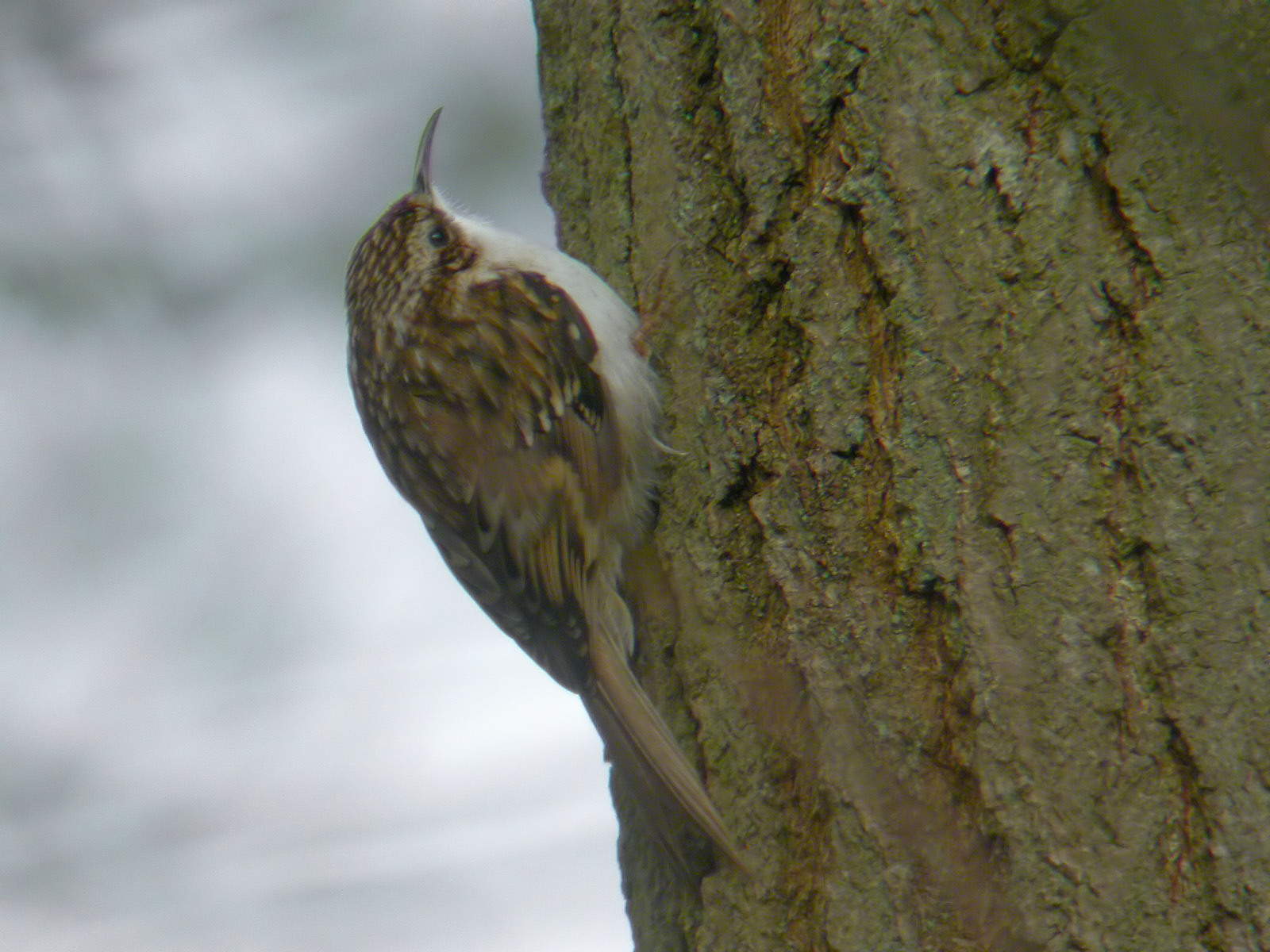
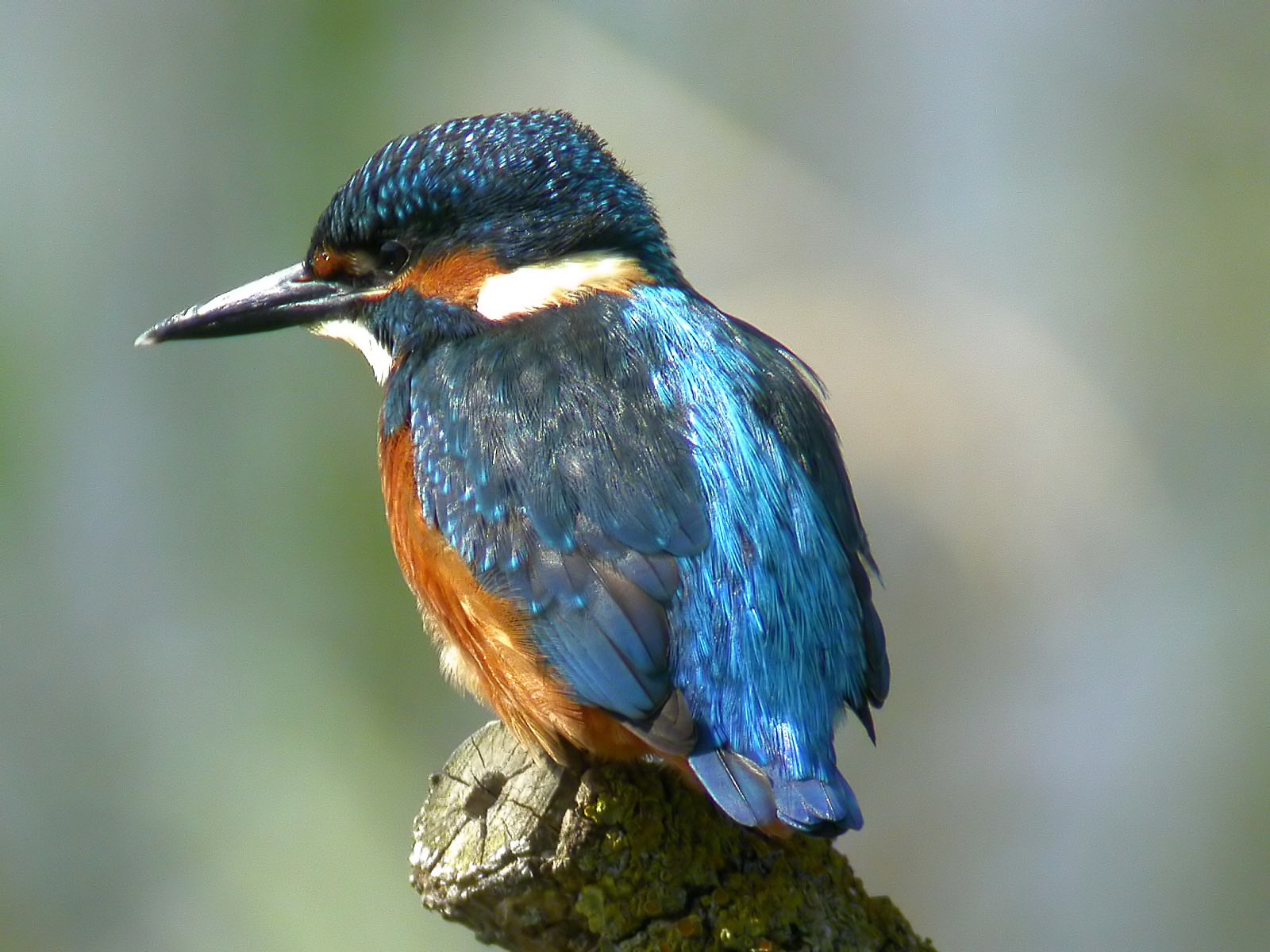
Monday 26th March - Ray Baker
I went down to the pond today to carry out a bit of carpentry, but had a look around the reserve on the way there and back. There was a male Blackcap singing loudly from the small copse next to the allotments - this is only the 3rd one that I've seen so far this Spring and the first to be in full voice, the other 2 birds have seemed a bit shell-shocked, although one was singing but in a decidedly half-hearted way.
When down at the pond, I caught a glimpse of a brown butterfly at some distance. It was too far away to be at all certain of id, but something about the way that it was flying made me think that a Small Tortoiseshell was the most likely species. I also saw another butterfly - no problem with the id this time - it was a Holly Blue and undoubtedly it had been stimulated to fly a bit earlier than usual by the warm weather.
Two more Buzzards passed overhead - I always think that their wild, mewing call sounds a bit out of place in our cosy surroundings... it sounds like it would be more at home in a windswept moor-top! There was also a fair bit of activity from our village flock of Jackdaws as they swept back and forth across the reserve - have to say that I am a fan of the Jackdaw... a very charismatic bird!
Finally I managed to get a half-way decent photo of the mysterious mining bees.... No closer to knowing what they are of course, but at least now, someone more knowledgeable has got a chance of being able to id it from my pic.
Holly Blue Mysterious mining bee
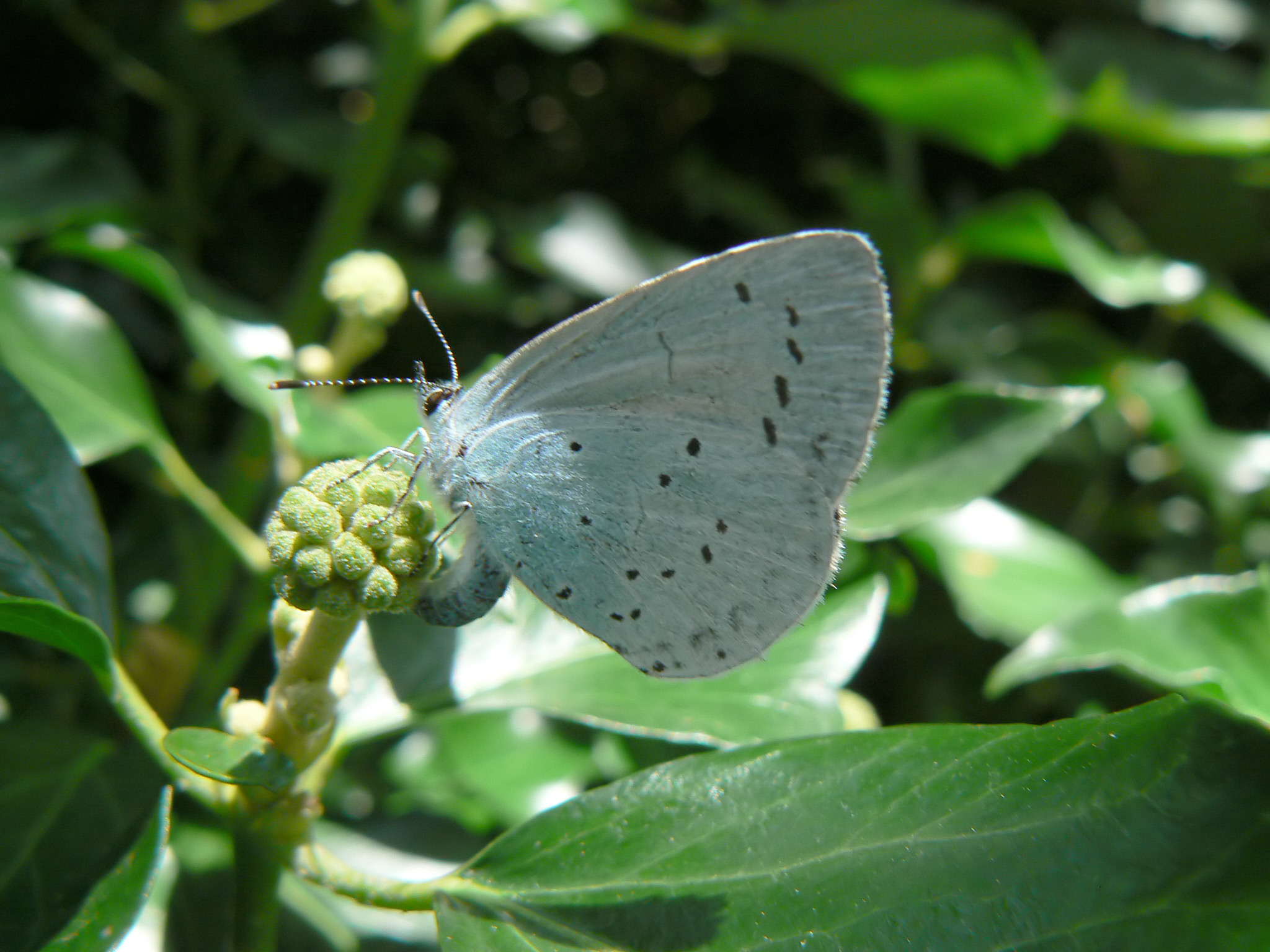

Sunday 25th March - John Madden
1.30 pm. After the work party I walked round the reserves. It was rewarding to discover two new species of plant which I had not seen before on the reserves. The first is ramsons or wild garlic which is growing in a fairly large clump along the garden boundary of Coldharbour. They look very pretty when their delicate white star-like flowers are in bloom. The second is ladies bedstraw which I found in the wildflower meadow. Unlike the ramsons which are almost certainly wild, this bedstraw will have been introduced during our recent attempts increase the number of species on the reserves. This plant has tiny golden flowers which are attractive to insects but we will not see them bloom until the Summer. Another plant which is now germinating and masses of its seedlings can be seen by the new ditch in Bloomers Field is yellow rattle. This is an annual which parasitises grass reducing its vigour and helping wildflowers compete. We have introduced it to the reserves and it is now beginning to spread. It is a wonderful nectar plant and loved by the skippers which favour the warmth and shelter of the new ditch.
Saturday 24th March - John Madden
7.30am. Whata glorious morning!My first site was the blackthorns in Cobham Hedge completely covered in flower buds like tiny popcorn. Some are actually in flower and it will not be long before they are covered in little white flowers like a dusting of snow. Other trees are in flower although they are less conspicious. You can see the flowers at the end of ash twigs looking like strange dark growths. It is pleasing to see the Lingfield Elm in Coldharbour Copse beginning to burst into life. Its leaf buds are fattening and showing green. Walking through the copse I looked for bluebell plants again and found quite a few more than I thought were there. When they eventually flower there should be a small but prominent display. Bird song was everywhere. It was a delight to hear a sky lark trilling away over the fields to the West. Yellowhammers were calling on the reserves too. I have been hearing them a lot this year and there are quite a few on the showground. I do not normally notice them till later in the Summer. As Ray said the nuthatches were piping away across the reserves and I saw bull finches in the orchard and by the scout hut (as usual). The frogspawn is now hatching and you can see the tiny shapeless tadpoles lying in the sun on top of the egg mass. There also seem to be a few wildflower seedlings emerging on the new clay banks. These could well be the survivors of the seed we scattered last August so fingers crossed that some interesting wildflowers emerge. I also saw the little burrows of mining bees which Ray referred to. Unfortunately I was too early in the morning to see any insects. This shows how important bare ground is as a wildlife habitat especially for insects and other warmth loving creatures. Our first cowslips in Bloomers Field have flower buds pushing up.
Saturday 24th March - Ray Baker
Another early morning visit and again no rarities but was able to see the 2 Green Woodpeckers flying around together which suggests to me that they are actually a pair rather than 2 males disputing territory. There were also a couple of quite unusual sightings - 2 rabbits running around in Coldharbour Copse and a Pheasant in Bloomers Field.... I imagine this had wandered through Cobham Hedge from the field beyond, where I have seen Pheasants on a number of occasions.
I did actually take a 2nd walk, at lunchtime yesterday, being quite determined to see some butterflies in the lovely warm sunshine, and mission accomplished with 2 male Brimstones, 2 Small Whites, 2 Peacocks (fighting, whatever next!) and a Small Tortoiseshell.
There were also a number of other interesting sightings with a breeding pair of Goldcrests and a Coal Tit in the quiet garden and a group of 8 Buzzards soaring over the pond area. It's not unusual to see Buzzards these days, but our area has only recently been colonised by this species, so to see 8 together is notable.
I also noticed that we have some sort of ground-burrowing bee which has colonised the sunny clay banks down by the pond. Don't know enough about bees to know what they might be, but there's a lot of them and looked rather interesting I thought!
Goldcrest Brimstone
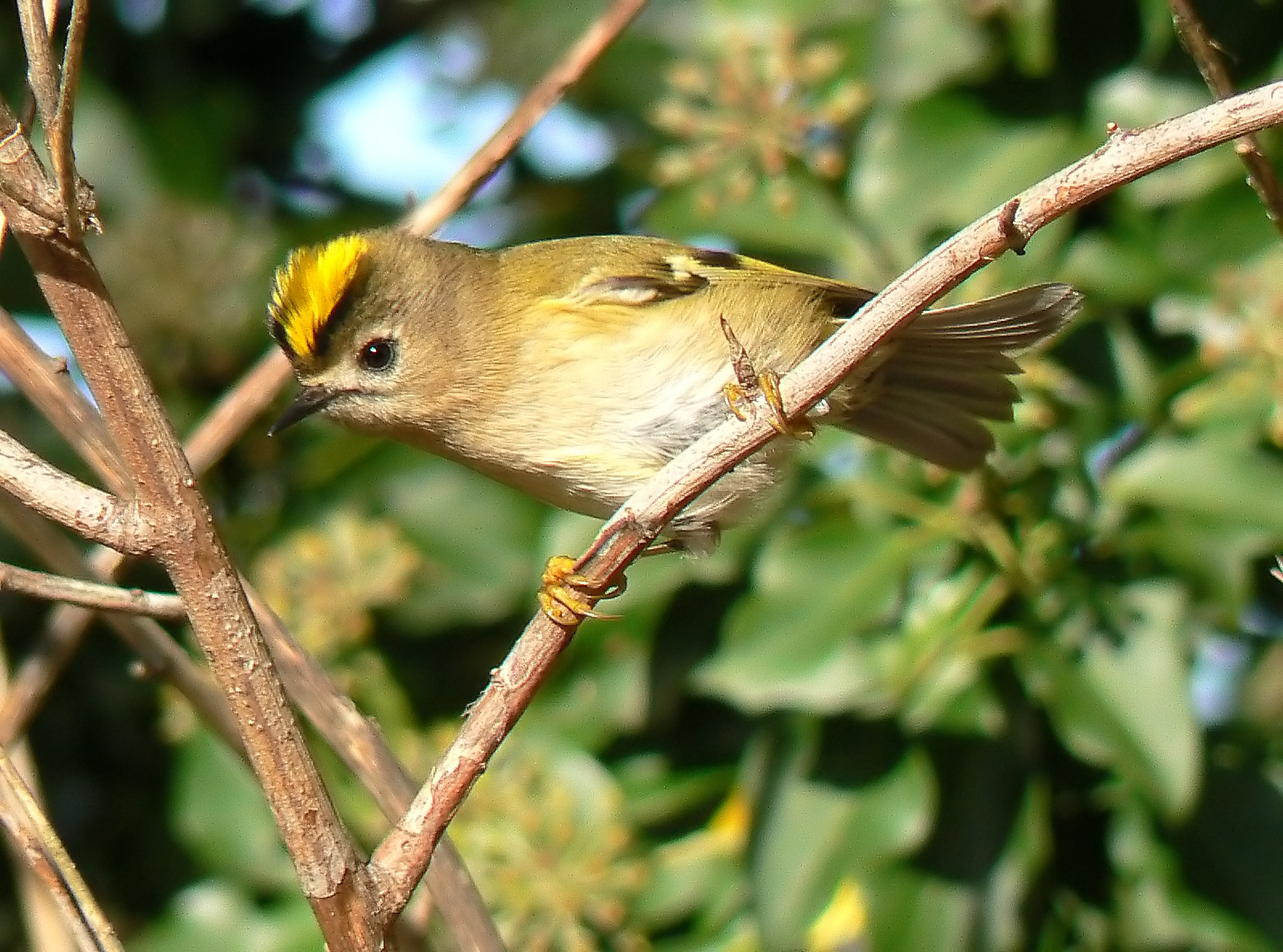
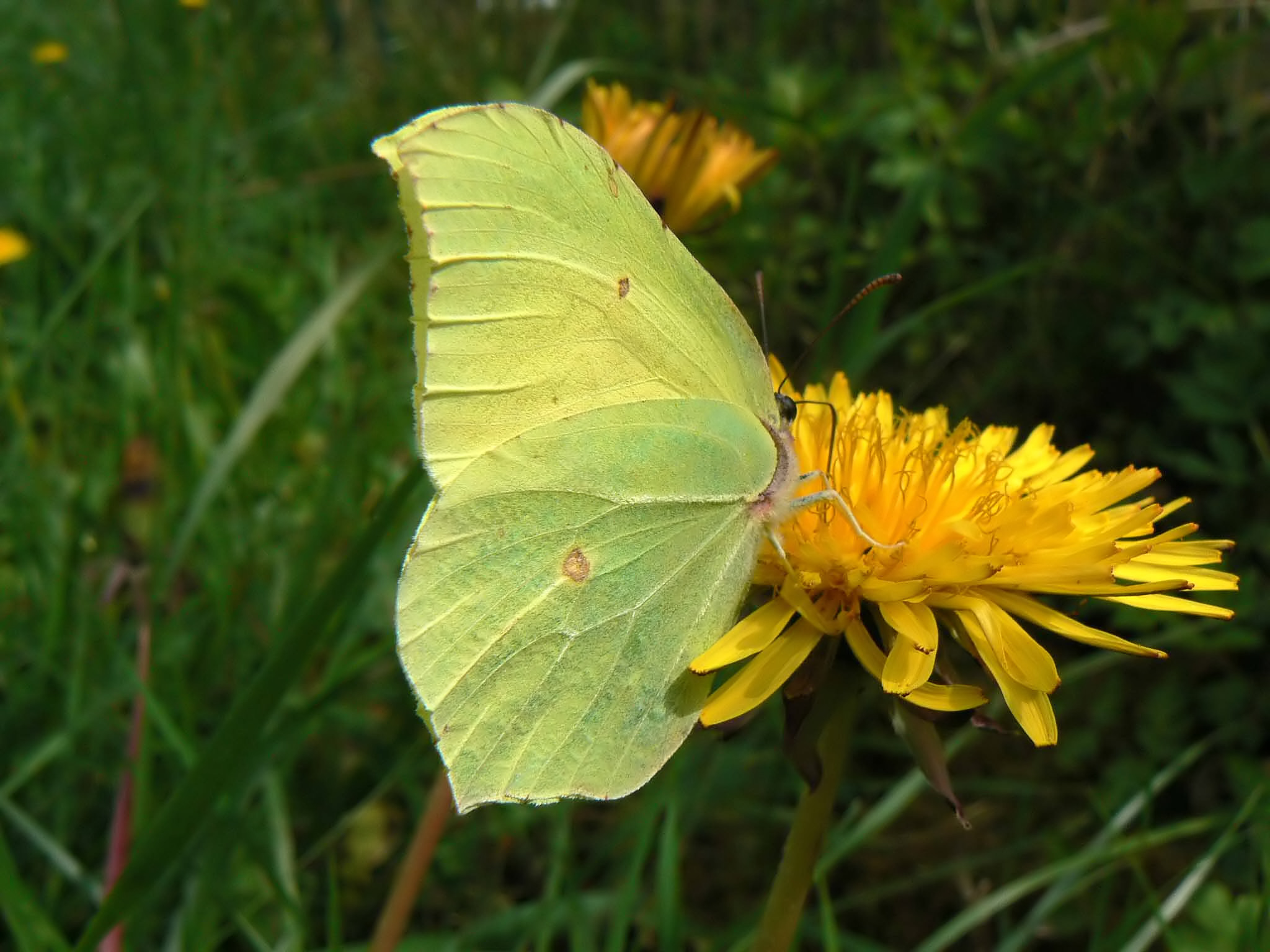
Friday 23rd March - Ray Baker
Having been woken by a pesky Blackbird singing outside my bedroom window at 04:45, I thought I'd take my own advice and go for a dawn walk around the reserve in search of rarities - nothing doing on the rare-birds front, but a walk around is never without interest, and so it proved today.
All of the usual suspects singing away loudly and once again I was struck by how many Nuthatches are on the reserve... There were at least 5-6 buzzing around the large trees in the orchard and BFG area, and I even saw a pair going in and out of a nestbox.... No reason why Nuthatches shouldn't use nestboxes - just that I've never seen it before myself.
I have also been keeping an eye on the Green Woodpecker which has been in the area recently and today I can report that there are actually 2 of them! This species is very shy and will usually fly off at the first sign of humans, so it is very difficult to assess what they're up to, but I suppose there must be some chance that they are prospecting for nesting opportunities.... I noticed that there are some holes in our Sequoia and I have been trying to see what, if anything, might be using them (woodpeckers being a likely suspect)
On a slightly more worrying note, I again failed to see any Linnets (only 1 brief sighting all year) and I would normally expect to see them looking for nest sites by now. In previous years, they have nested in the gorse bushes, and I imagine that the problem may well be that 3 out of our 4 mature gorse patches have been burnt down by vandals, so we no longer offer enough prime nesting habitat for this increasingly rare species. We planted some young gorse last autumn and hope to plant some more later this year, but obviously it will take a few years for these to grow to a suitable size. It just goes to show that habitat destruction doesn't necessarily mean agri-business turning hedgerows into prairies - it's all too simple for the actions of anyone to achieve destruction on a local level.
In an illustration of the importance of gorse though, whilst I spent a fair bit of time in a fruitless wait for Linnets to show themselves, I did notice a pair of Long-tailed Tits and a pair of Bullfinches which appeared to be nest building in the one remaining thicket, so here's hoping that no harm comes to that one.
Linnet Nuthatch
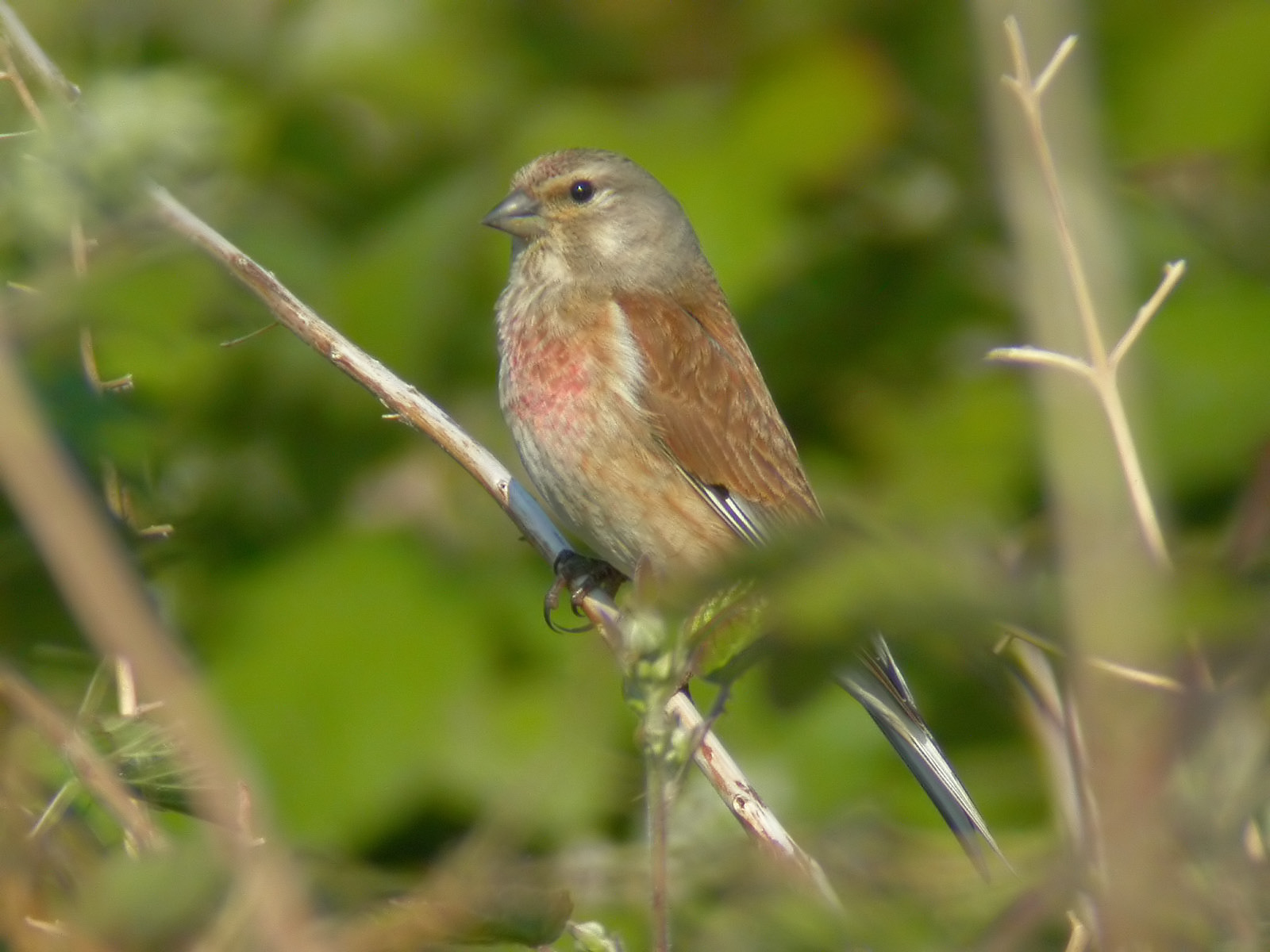
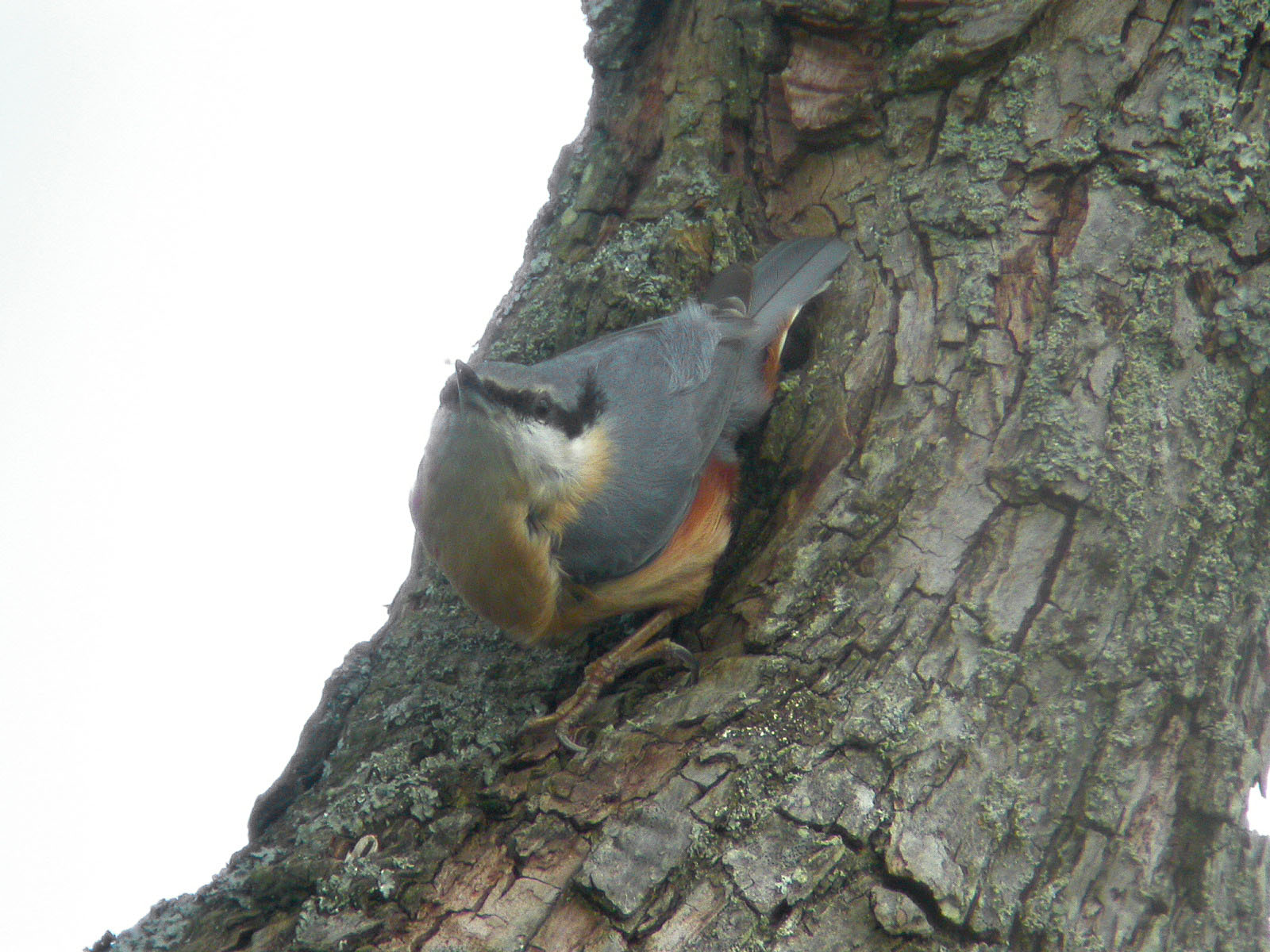
Wednesday 21st March - Ray Baker
It felt very much like a changing of the guard today, with Chiffchaffs singing everywhere in the warm sunshine and not a sign of a Redpoll, Siskin, Fieldfare or Redwing.
It was also a day of 'nearly' - as I saw a Treecreeper just outside the reserve by Coldharbour, 2 Red-legged Partridges over by the showground, a Kingfisher at Blindley Heath and finally a soaring Sparrowhawk which might have just about crossed over the boundary of the reserve by Cobham Hedge as I finished my walk.
Now is a good time of the year for keeping your eyes peeled, as we have many migrants species which will be passing through over the next few weeks and it is not unknown for them to stop-over for a day or two, particularly if the weather is bad, so we might see something like a Wheatear, Redstart, Willow Warbler etc. In addition to migrants, we also get what are known as 'vagrants' which basically means birds that are lost - often over-shooting their intended destination and ending up in good old Blighty instead - and this could be more-or-less anything!
I am yet to see my first butterfly on the reserve this year - only a matter of time though, as I have seen several species nearby!
Chiffchaff Sparrowhawk
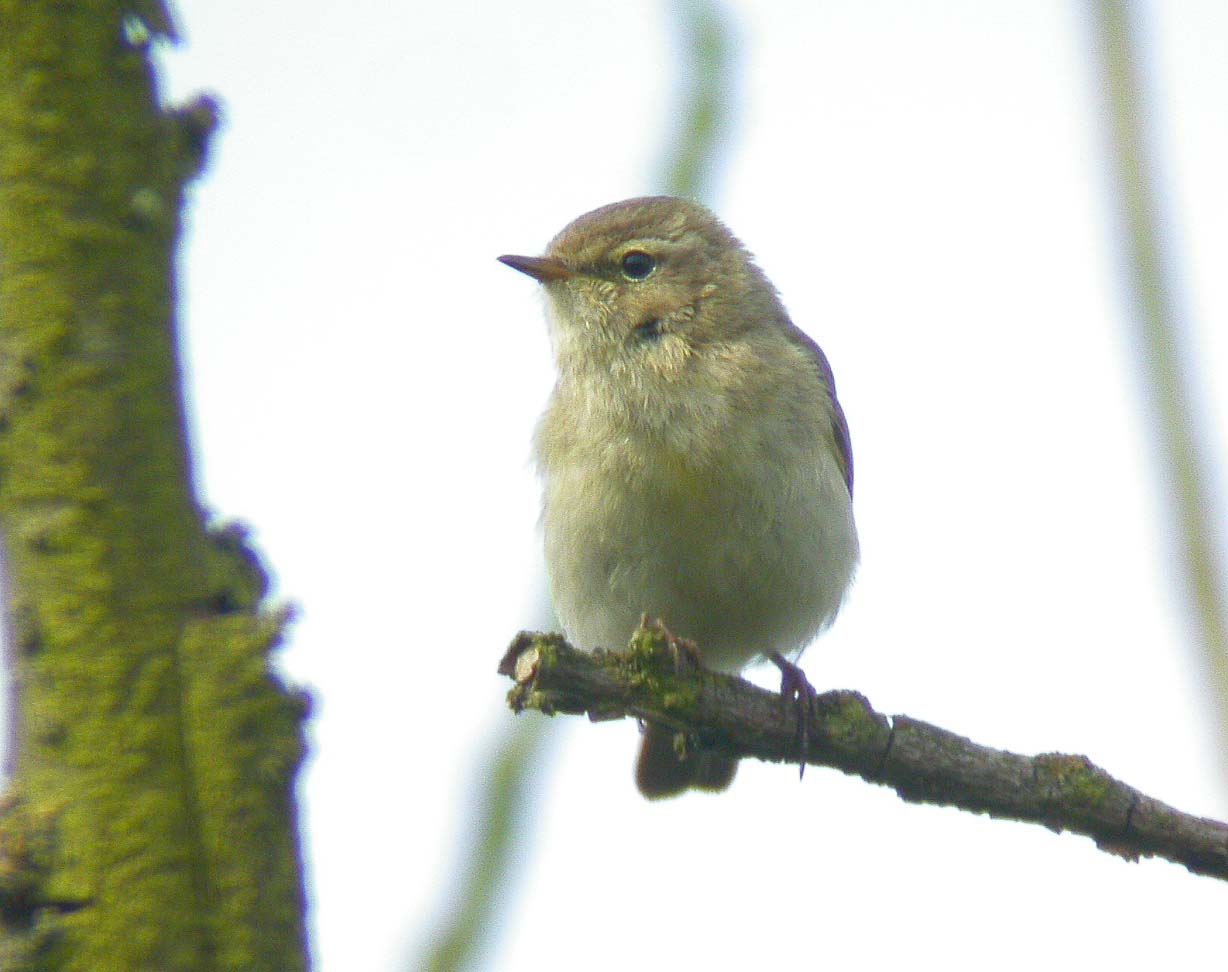
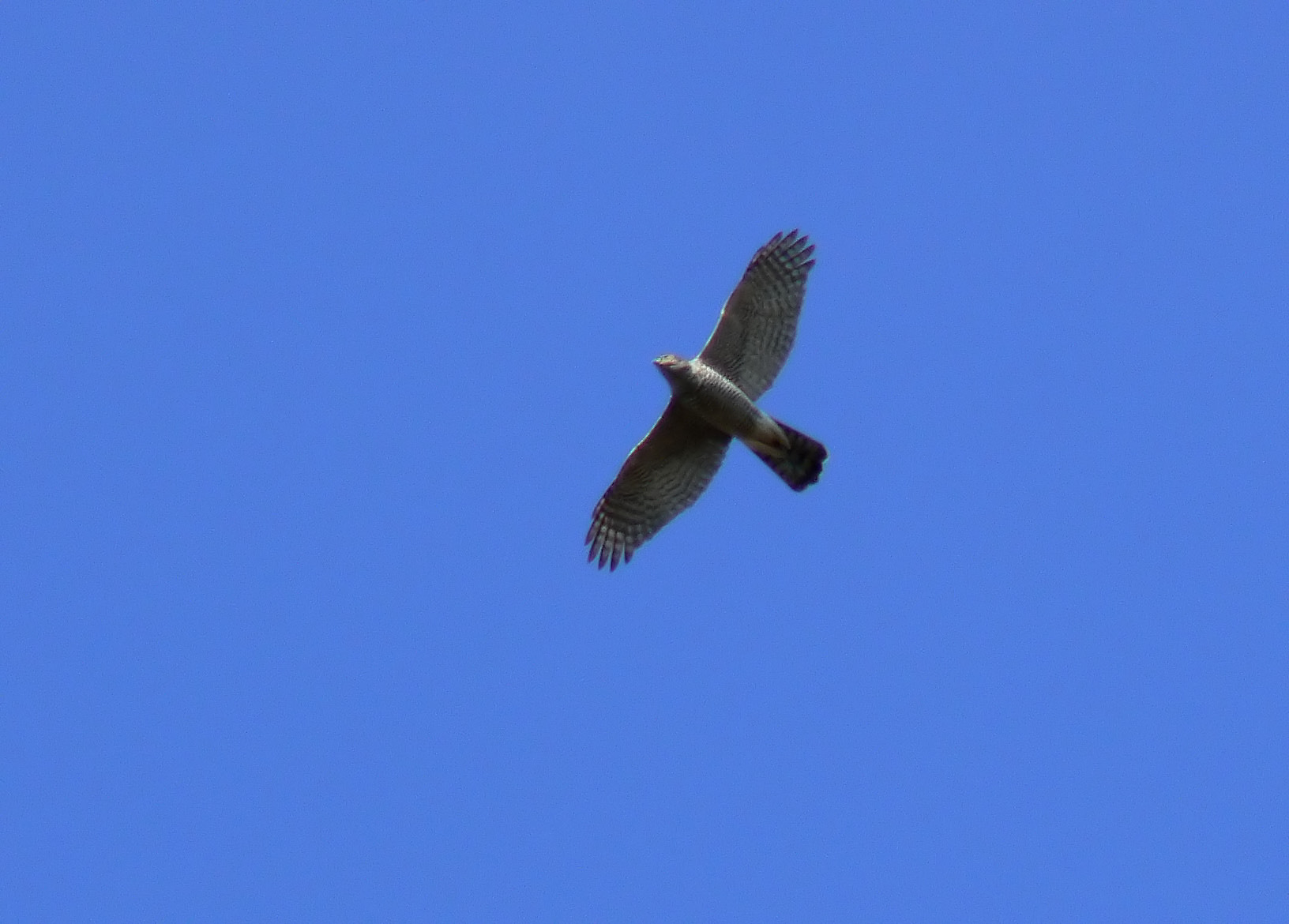
Tuesday 20th March - Ray Baker
Heading over to the reserve this morning and heard my first Chiffchaff before I'd even finished pulling on my wellies - singing from the large oaks at the top of the Community Orchard, and then a further 2 in the area of the allotments and WFM - Spring is now officially here! The flock of Redpolls are still around - maybe more than one - since I saw them by the stream and pond area, and also by the WFM... Surely can't be long before they disappear, as they are mainly a Winter visitor in these parts. Mind you, I still have a flock of Siskins frequenting my feeders, and both of these species operate to the same sort of timetable.
Noticed lots of Blue and Great Tits prospecting the nest-boxes around the reserve and a Yellowhammer was singing from the large oak by the bridge before being flushed by a dog-walker and reverting to its more usual position up by the footpaths at the top of Beacon Field.
I mentioned about the atmospheric scenery early on Sunday morning.....
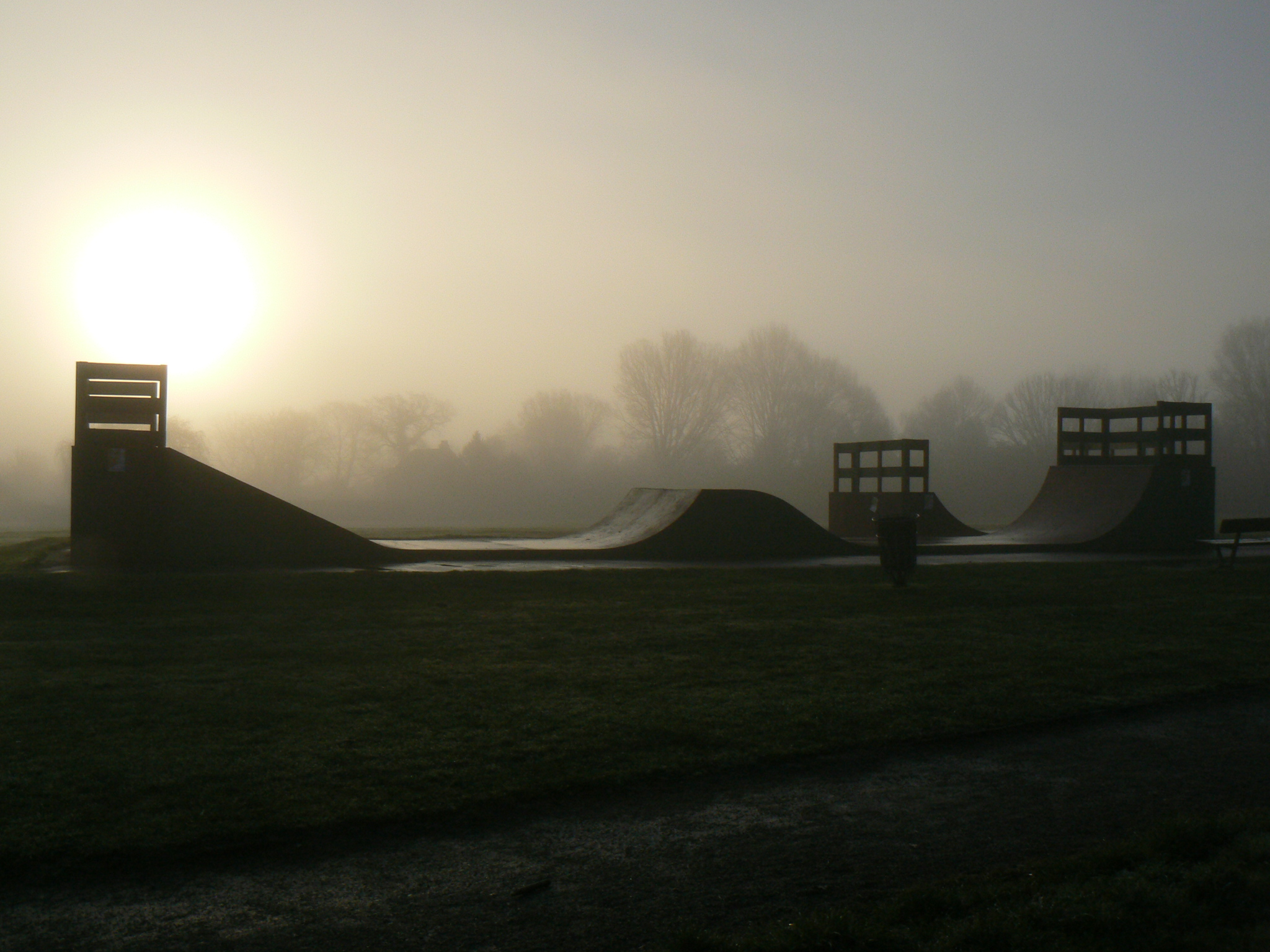
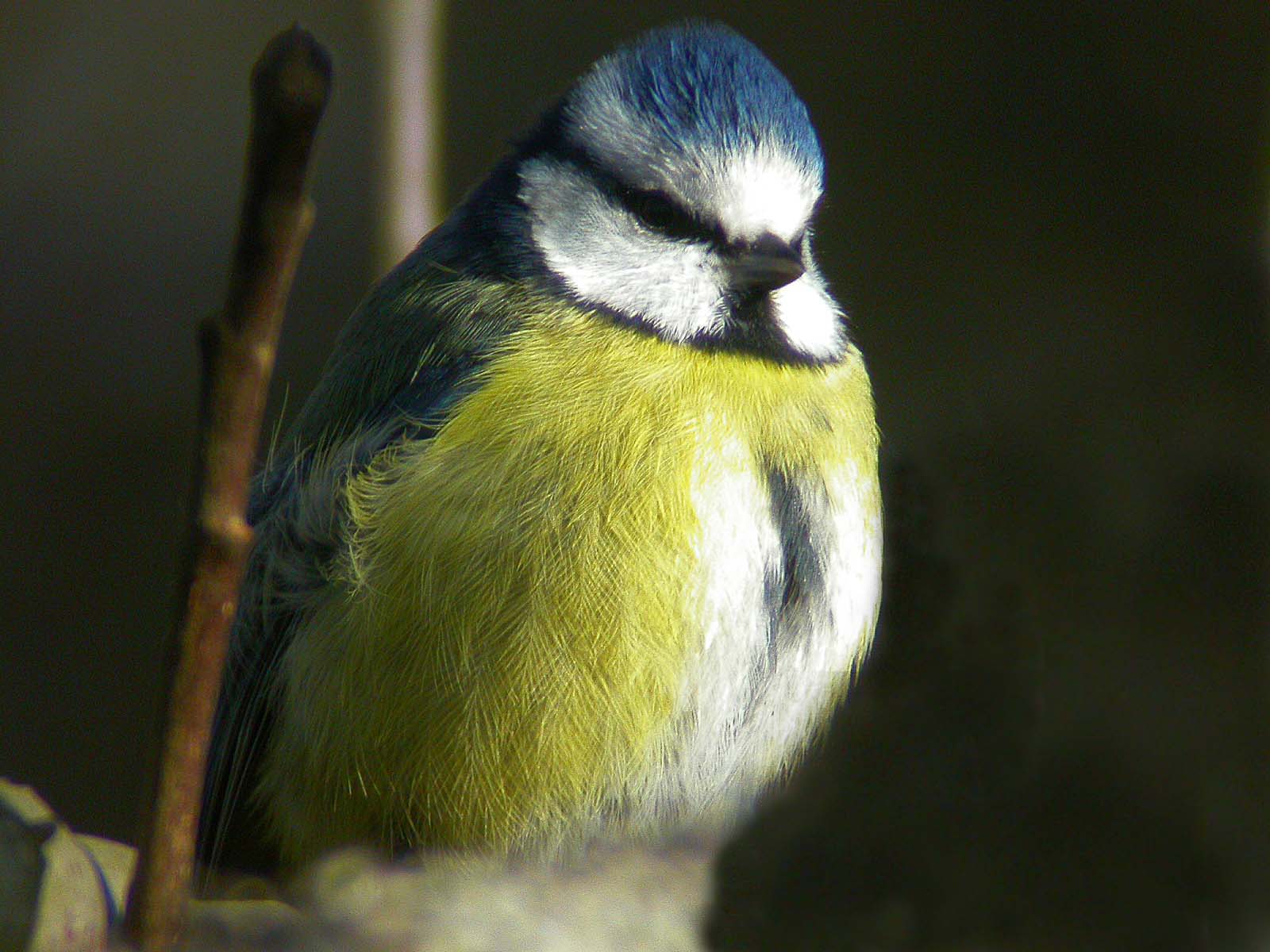
Sunday 18th March - Ray Baker
I went over to the reserve just after dawn this morning and it was a very atmospheric walk - chilly with a thick mist which quickly burnt off as the sun came up, giving way to a lovely clear blue sky. The reserve was full of birds and song, with our all-year-round species very much in evidence prior to the arrival of the Spring migrants, and Robins, Blackbirds, Wrens, Dunnocks, Nuthatches, Greenfinches, Chaffinches, Song Thrushes and Goldcrests were all belting it out.
There were a few unusual sightings today - a group of 6 Jays were in the trees above the stream, a Grey Heron flew slowly overhead and some Geese flew by somewhere near, but I couldn't pick them out of the mist. The pair of Great Spotted Woodpeckers were flying around the orchard and a Green Woodpecker was patrolling the large trees near the butterfly garden and yaffling loudly. There were 5-6 Nuthatches flying around the 2 large chestnuts (a family group from last year?) and I saw my first migrant of the year - a male Blackcap - in Derek Slade spinney. It wasn't singing and looked a bit shell-shocked to find itself in the rather frigid conditions.... you could just imagine it thinking "I gave up the Costa del Sol for this!?"
Later on in the morning, I went for a longer walk down towards Blindley Heath and saw/heard 3 Chiffchaffs, so it won't be long before there are more migrants on the reserve, plus when checking out the pond, Mrs B picked out 2 Buzzards drifting by overhead. I also saw a butterfly at Blindley Heath.... couldn't get a good look as it zoomed by, but I thought it was probably a Small Tortoiseshell.
male Blackcap (female has a brown cap!) Green Woodpecker
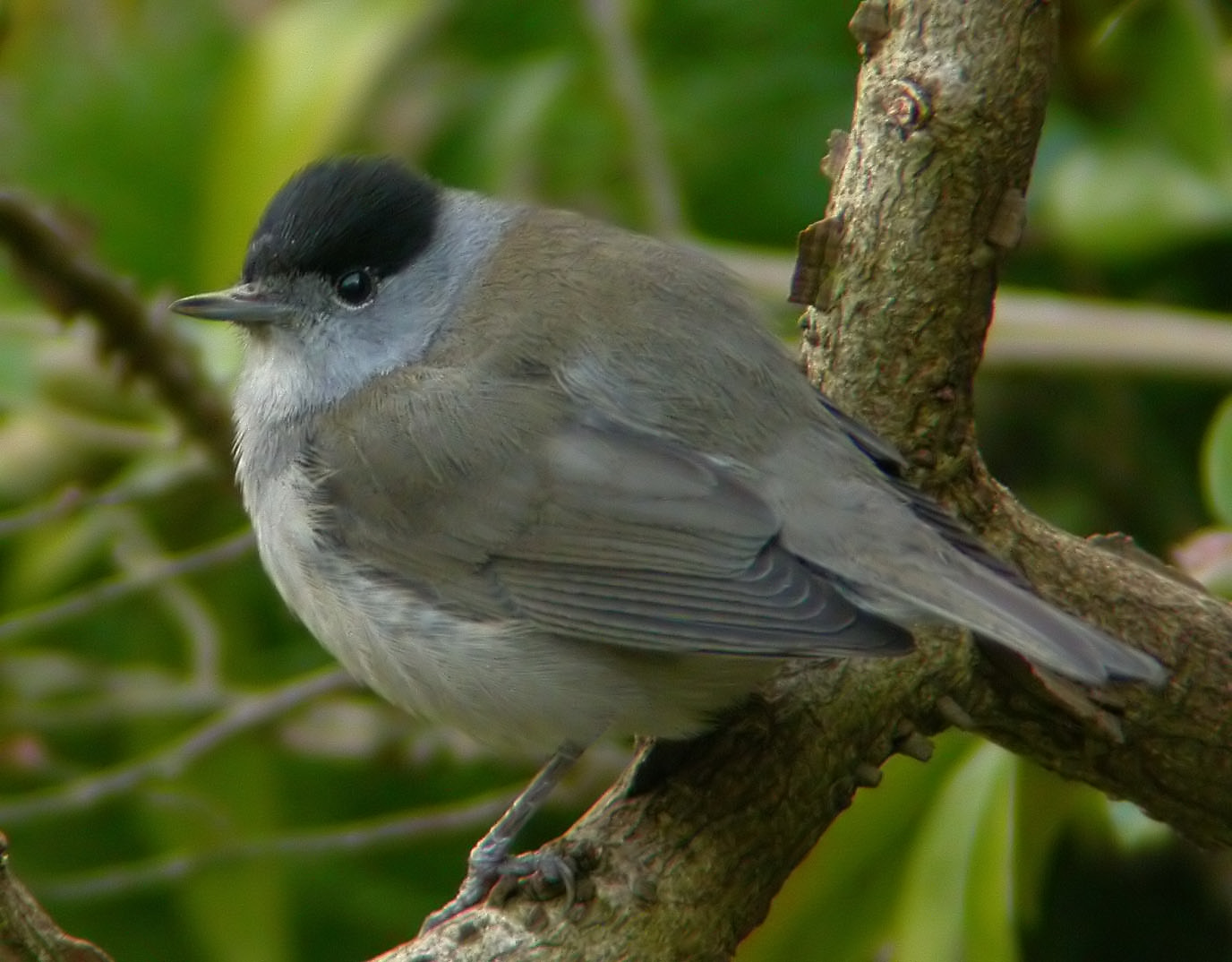
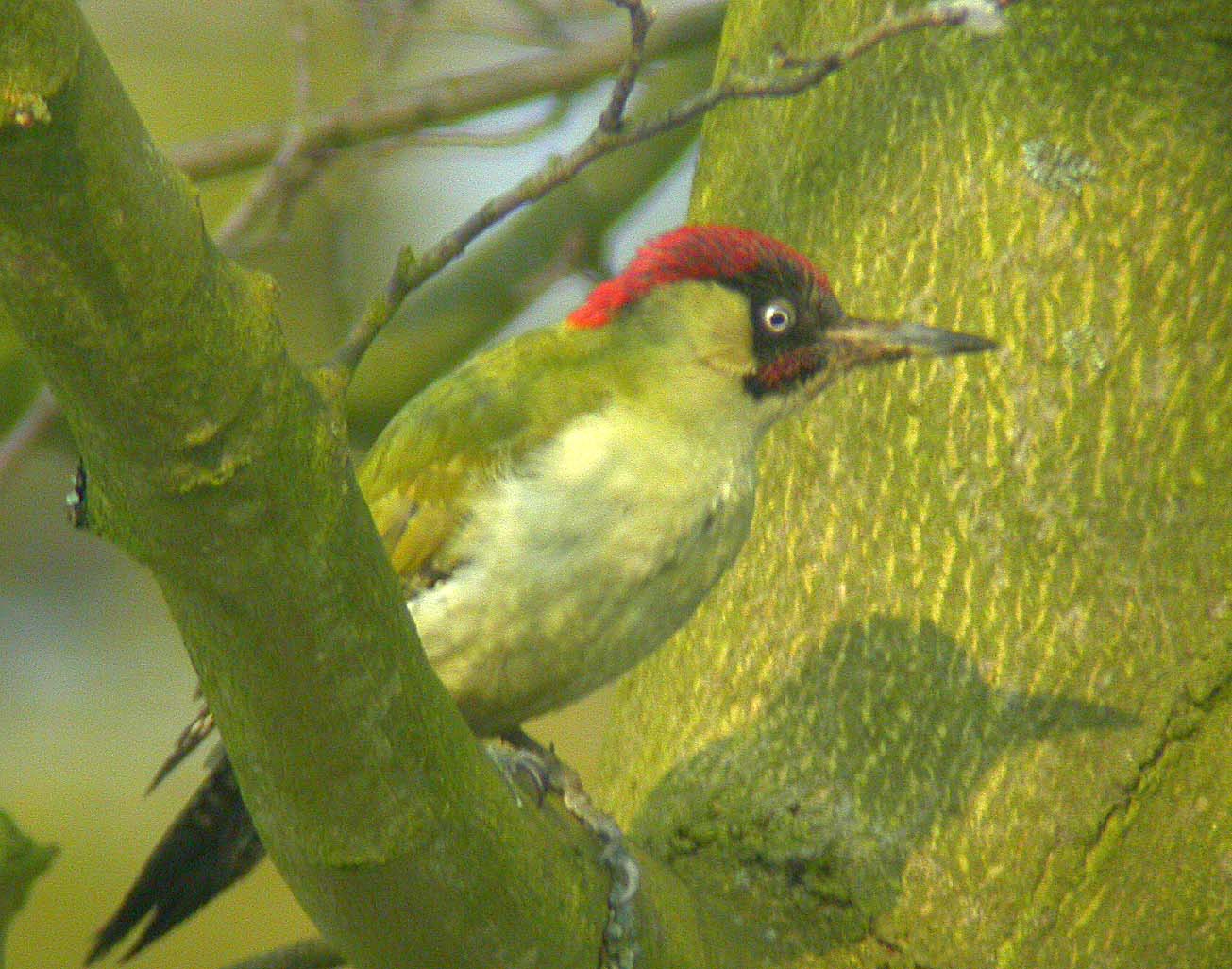
Saturday 17th March - John Madden
Robin seen with nest material in its bill by the scout hut. It is easy to see smooth and great crested newts in the relatively clear smaller pond. There are still three clumps of frogspawn in one of the pools dug last August. Some of the embryos are now developing. You can see they are already elongating when compared with the little black ball in newly laid spawn. Spring is now progressing at pace. The flowers of the goat willow behind the ponds are already fading. It is heartening to see the flower and leaf buds on the fruit trees in the orchard swelling and just begining to open. The quince leaf buds are quite well progressed while the elders are covered in small bunches of new leaves. I managed to find a handful of bluebell plants in Coldharbour Copse. These have grown from seed collected in local woods then scattered in the copse. They are probably too young to flower this year as it normally takes several years from germination. Like Ray I keep seeing a pair of pied wagtails in Jenners Field. We have not recorded this species breeding on the reserves.
Friday 16th March - Ray Baker
I went over to the reserve this morning in the hope of hearing some early Spring migrants - maybe a Chiffchaff or Blackcap - but no joy and, in truth, any bird turning up today from warmer climes would have had quite a shock, as it felt about 10-15c cooler than yesterday.
There was a Yellowhammer singing from the hedge at the top of Beacon Field (where the 2 footpaths exit the reserve) and the Blackbird with the white head was sitting on top of the field shelter. Down at the pond there were a male and female Bullfinch feeding on the last of the berries and I spent some time in a fruitless attempt to get a photograph of the female. There is a photograph of a male and female Bullfinch together here, as well as a recording of their call. In my own experience, the call is usually a far quieter and more pathetic version of the recording on the RSPB website, but is nonetheless very distinctive and will very often be your first alert to the presence of this shy bird, which is one of those species which is almost invariably 'on the other side of the hedge'..... If you see a Bullfinch fly, look out for the distinctive white rump, which is very obvious in flight. You can hear a Chiffchaff singing in the background too!
There were also 2 Goldfinches feeding in the hedge that border the houses behind the pond, and the usual 2 Pied Wagtails were feeding in Jenner's Field.
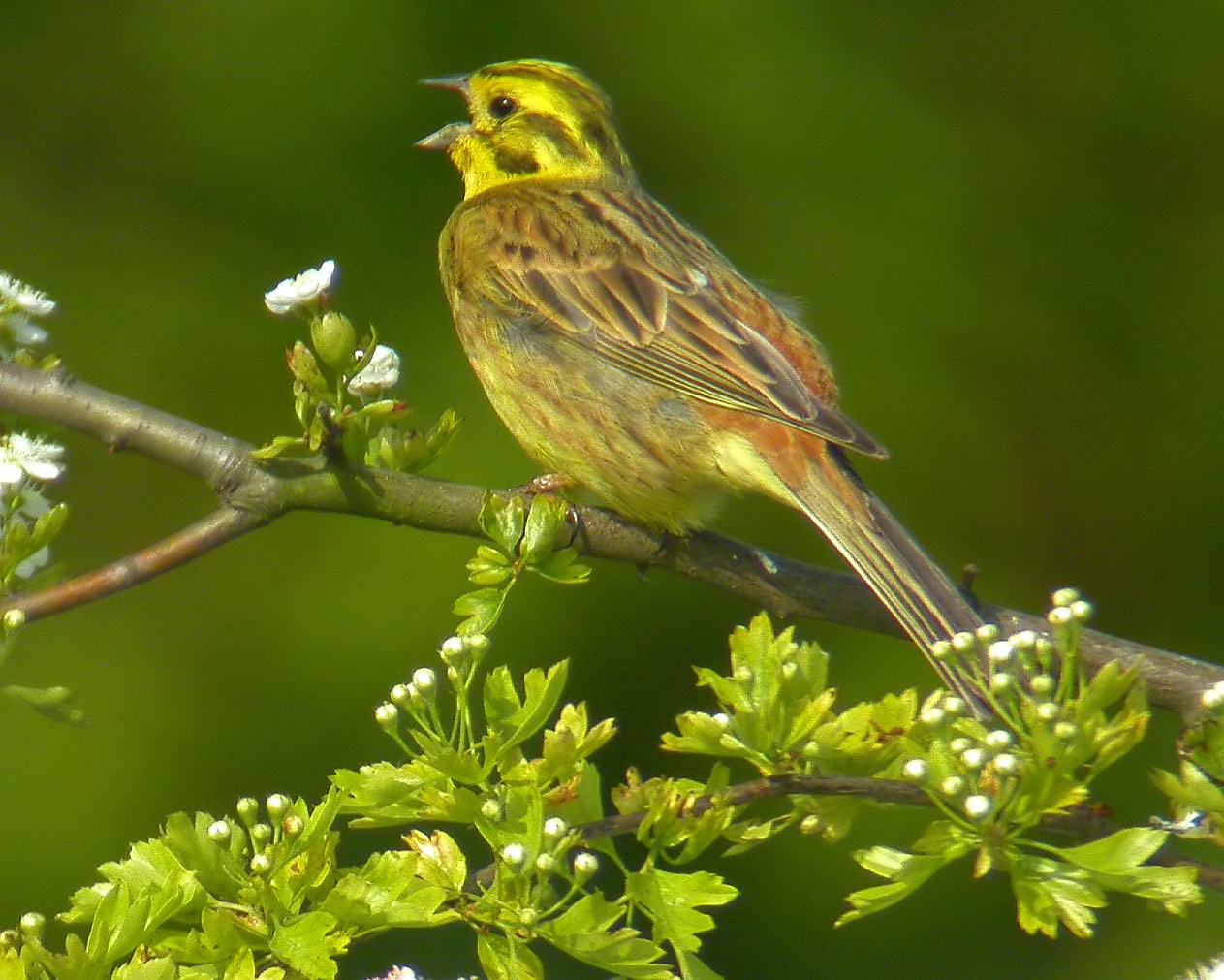
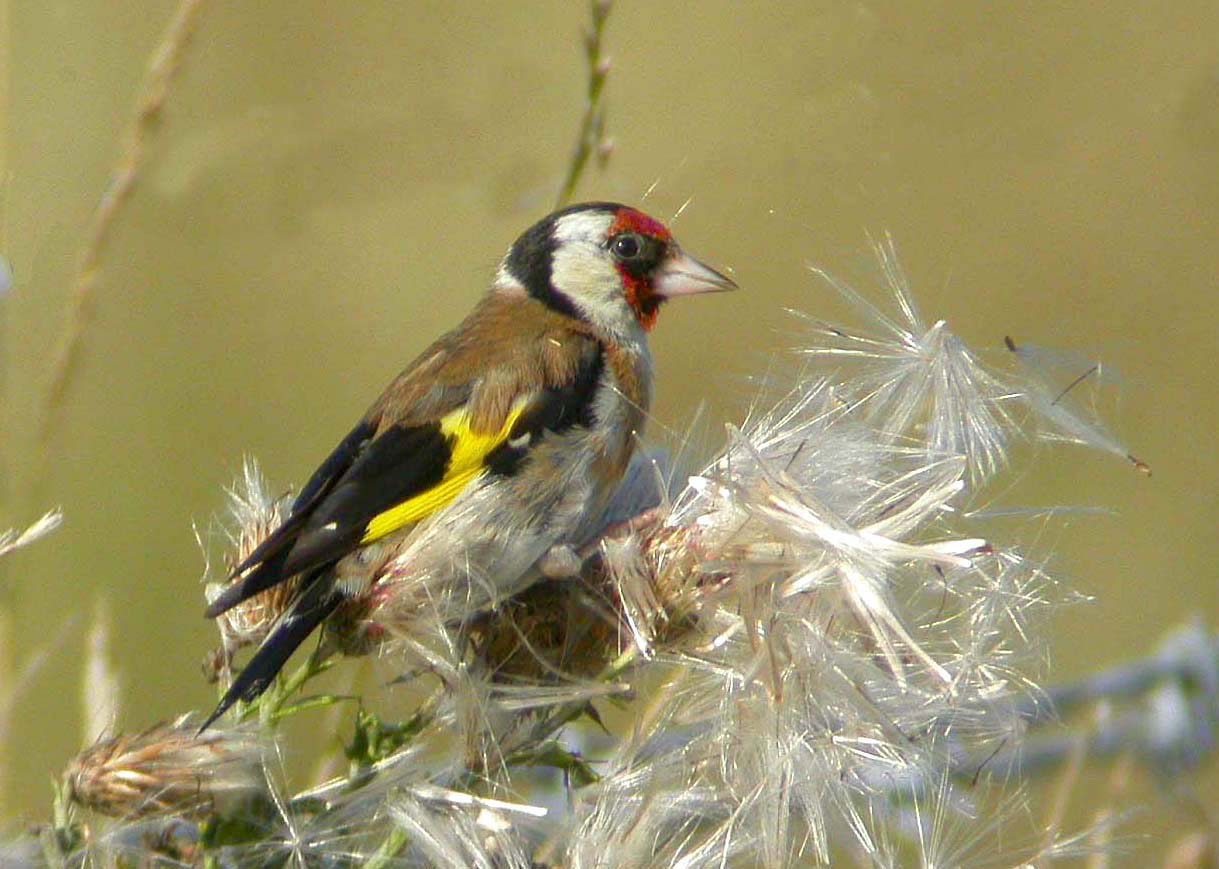
Thursday 15th March - Sally Cole
We showed a young biology student around the Reserves this afternoon. He is particularly interested in the environment and conservation and, hopefully, he is going to come and join us for some of our events and work parties on the fields. We intend to do some meadow sweeps later in the summer when the grasses are at their highest and Dan may be able to help us to identify the 'catch'. Whilst walking about, Ray identified the call of a Bullfinch in the trees at the Coldharbour entrance to Bloomers Field. Looking up, we saw the male Bullfinch with his lovely pink breast perched on a branch above us. Later we saw a Greenfinch in the trees of the Quiet Garden, singing away happily - his call again identified by Ray. I have to admit that both Dan and myself were as green as the Greenfinch where bird song is concerned. We walked around the ponds and saw both Great Crested and Smooth Newts galore in the upper and lower ponds. This bodes well for our first pond-dipping session of the year.
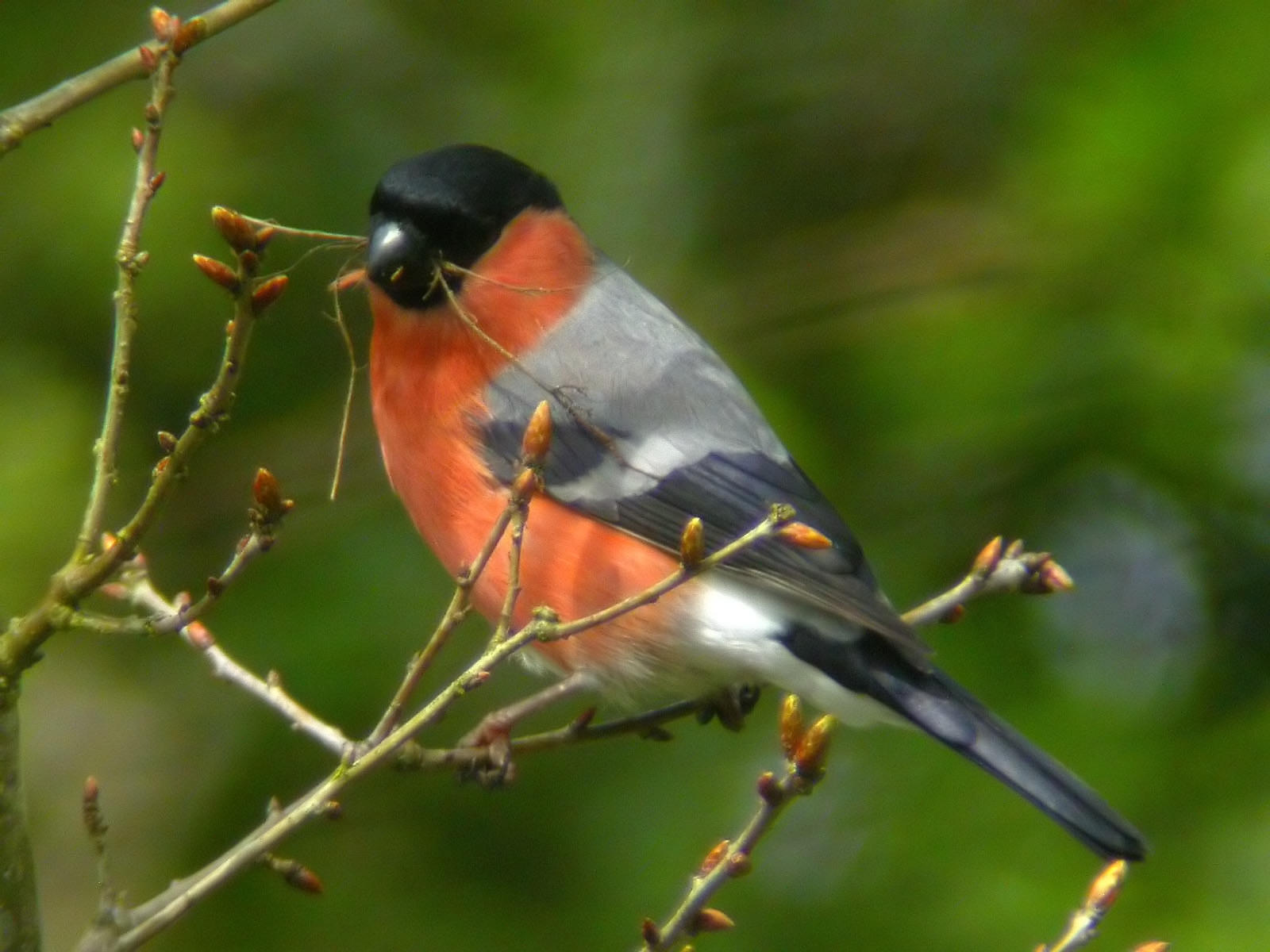
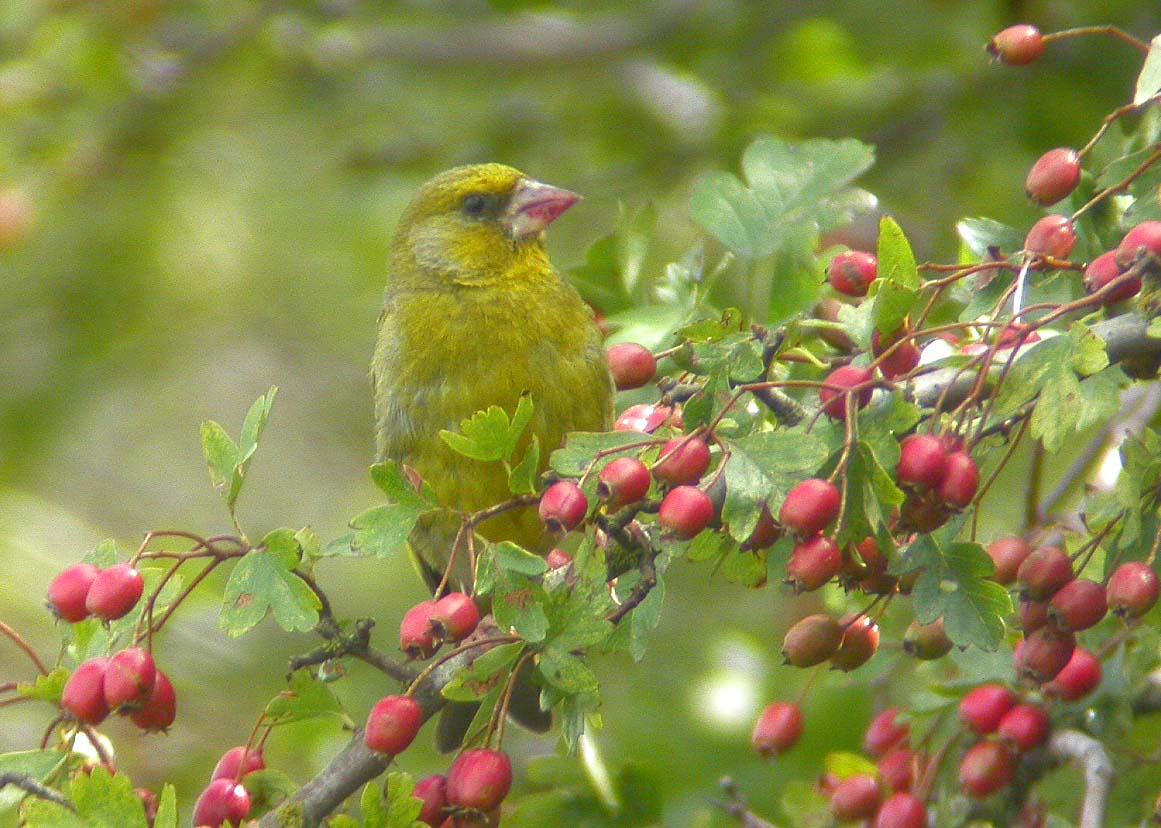
Monday 12th March - Ray Baker
Quite an unusual sight down at the pond today, with a male and female Mallard sculling about serenely on the small pond (beers cans not quite so unusual!)
Definite signs of Spring in the air - I had seen 2 butterflies while working in my garden (Brimstone and Small White) and popped over to the reserve to see if I could see my first butterflies of the year - but no... I did see this bee demonstrating the importance of early-season food sources though.
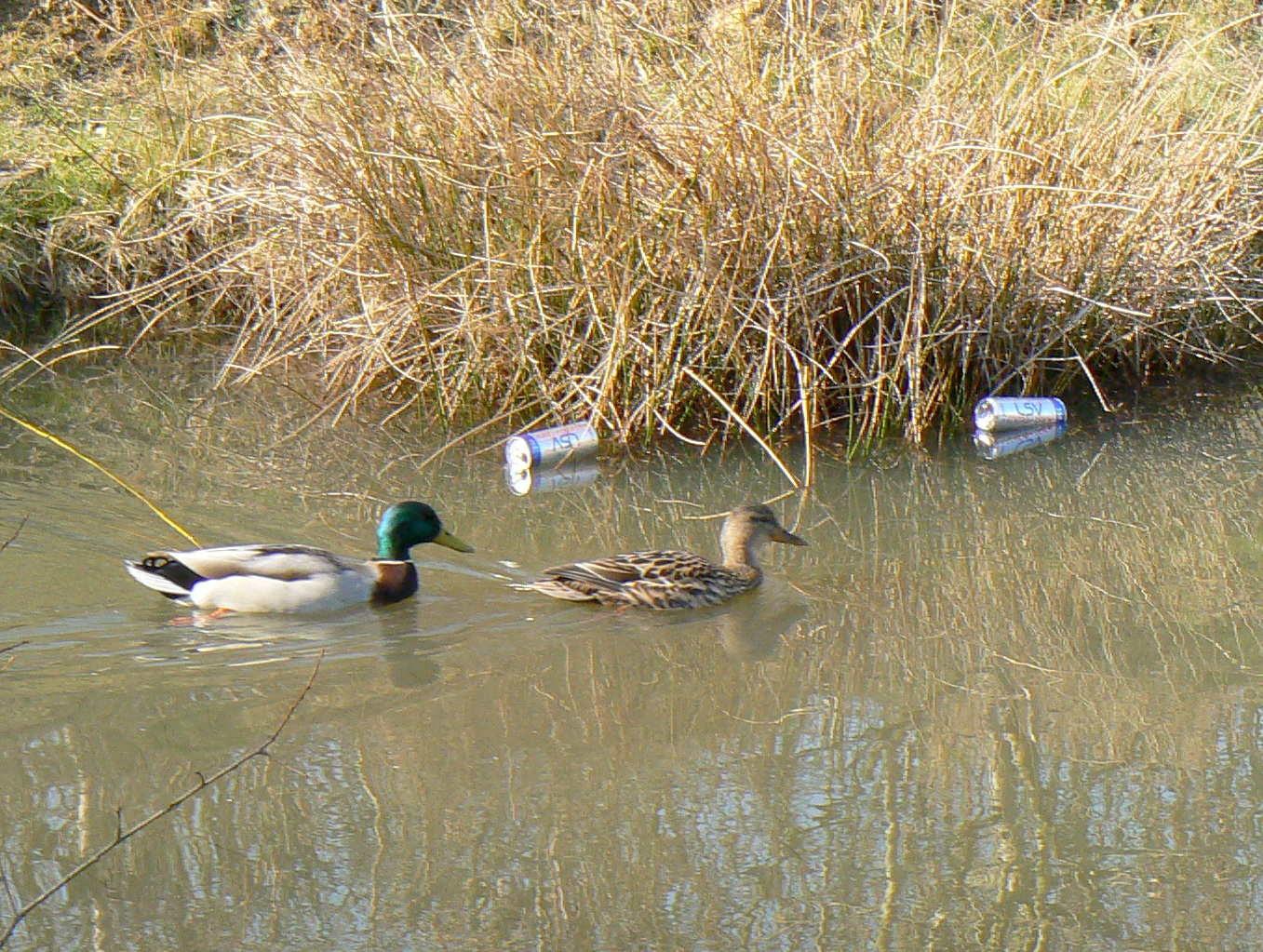
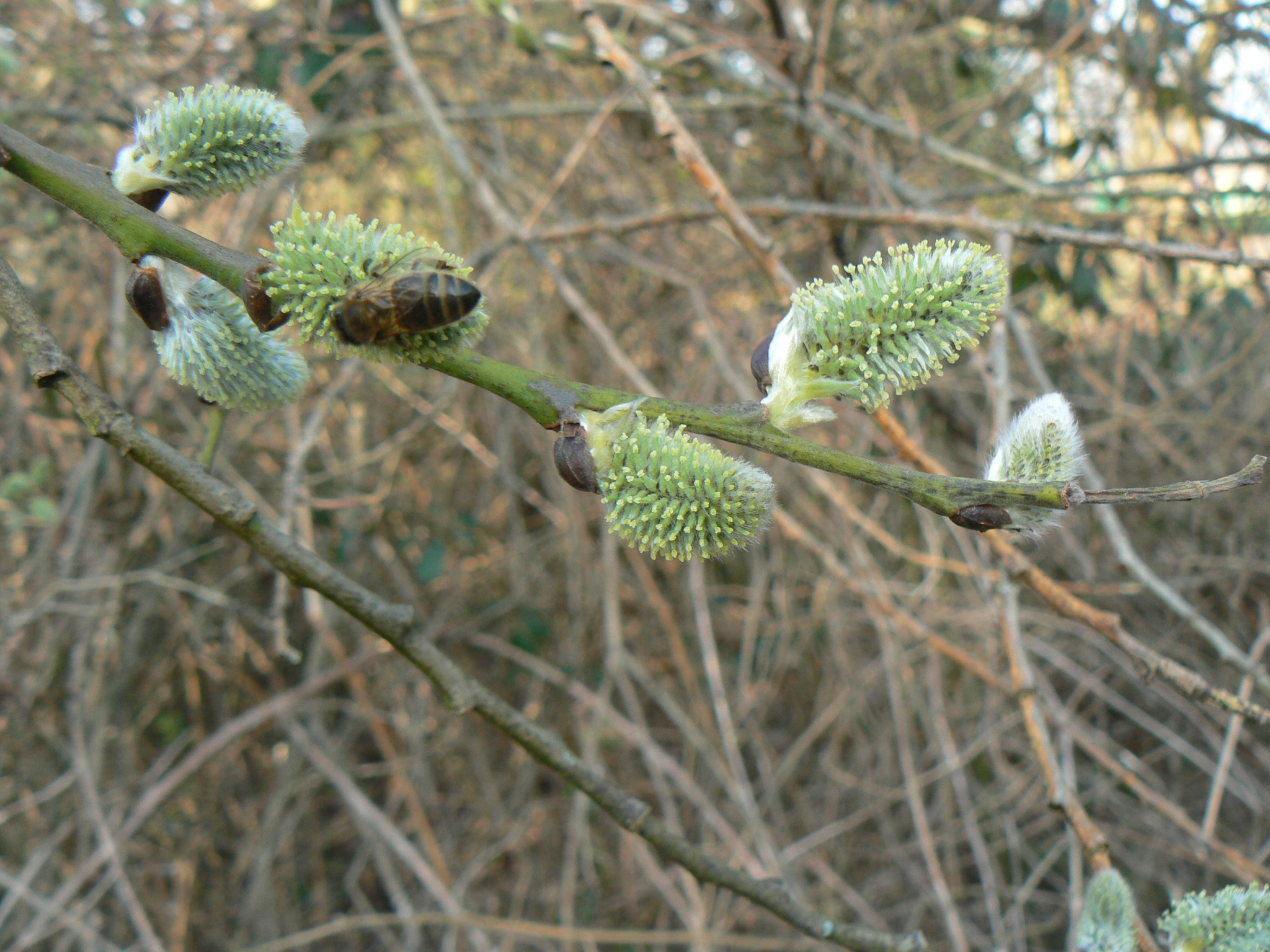
Sunday 11th March - Ray Baker
OK - everyone can relax! Paid another visit to the pond again today and normality has resumed, with plentiful sightings of both Smooth and Great Crested Newts - I wonder if they are more active in the warmer weather? There was also more frogs-spawn and frogs sitting in both of the new scrapes.
A Magpie was busy refurbishing an old nest in Coldharbour Copse and paused long enough to see off a Jay, which was obviously getting a bit too close - as you might imagine, an altercation between a Mapgie and a Jay was quite a noisy affair!
I was pleased to hear a Skylark singing just outside of the reserve - they used to favour the field outside the reserve next to the Community Orchard but had been driven out of there last year by the agricultural work that was taking place. I have also heard a Green Woodpecker yaffling from down by the Coldharbour area but have yet to see it on the reserve.
Talking of Woodpeckers, I have been keeping an eye on the Great Spotted Woodpeckers and today saw both male and female together flying around the chestnuts... I also saw this Blackbird with some aberrant plumage. I had previously seen it last year - it hangs around at the top of Beacon Field where the footpaths leave the reserve.
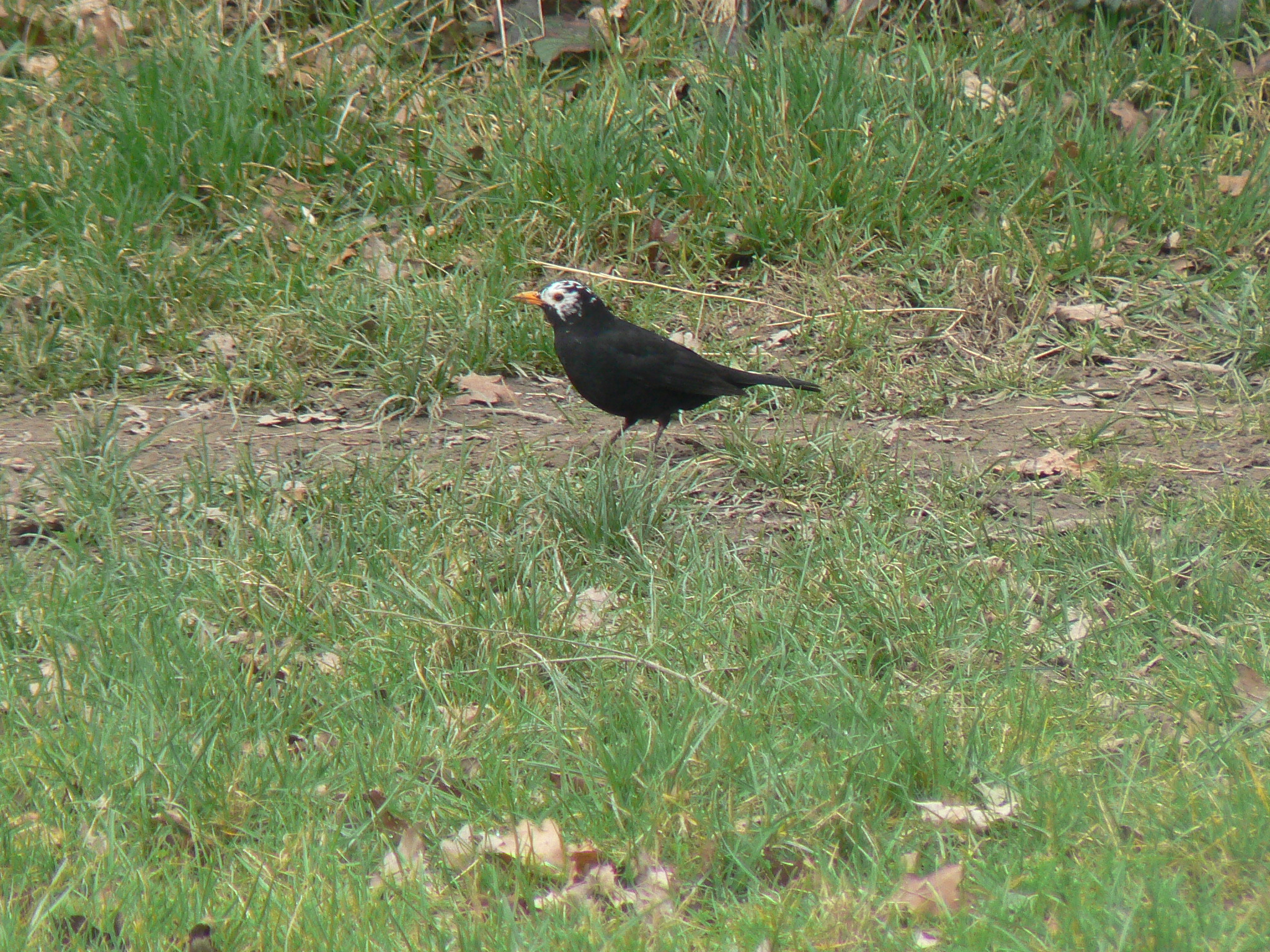
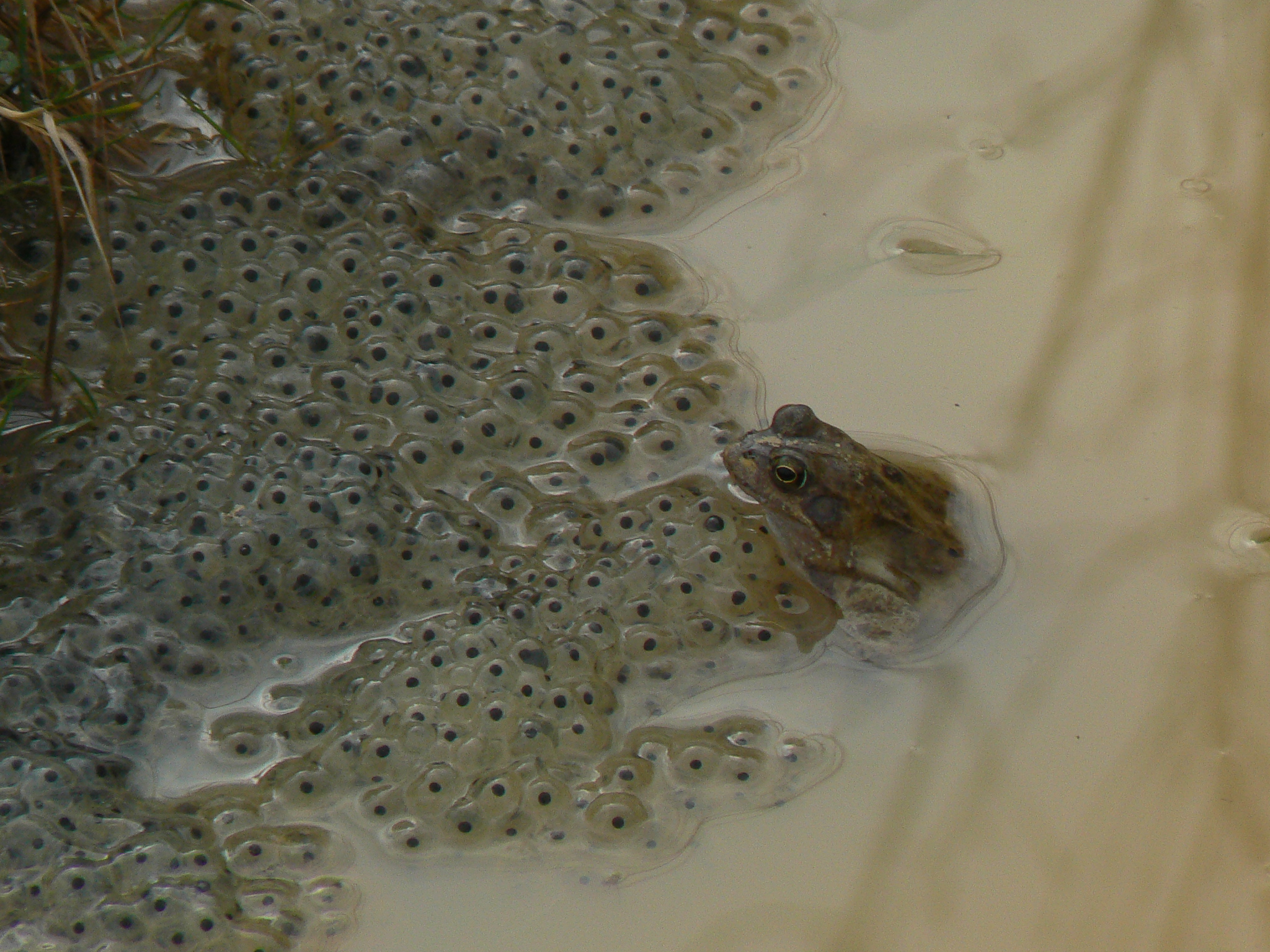
Thursday 8th March - Ray Baker
Perhaps I should start a new page - 'non-sightings' - since the story today was about something that I expected to see but didn't.... namely newts! When I was at the pond last week, there were loads of newts around - both clearly visible in the upper pond and being sighted (sometimes half-a-dozen at a time) as they came up for air in the larger pond. Today - not a single one! I don't know enough about the life-cycle of newts to know whether this might be normal, or some sort of ominous development. Time will tell I guess...
One thing that I did see was that there was a decent-sized clump of frogs-spawn in one of the new scrapes.... Our purpose for building these was as a habitat for the frogs, as we felt that the tadpoles wouldn't have much chance in the main ponds, due to them being a prey-item for our many newts. It remains to be seen how well this spawn and tadpoles will get on - fingers crossed for them.
Saw these very pretty daffodils in the woods behind the butterfly garden on my way home...
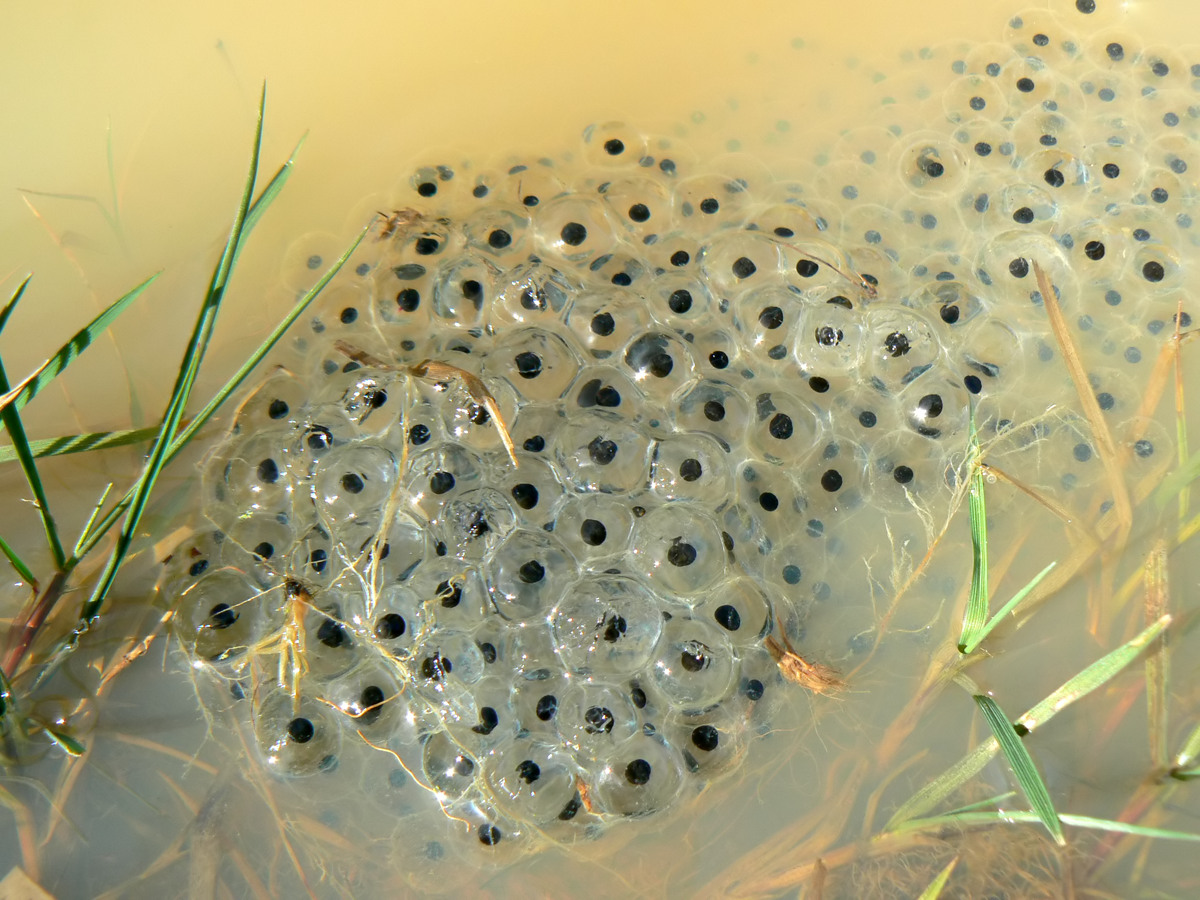

Monday 5th March - Ray Baker
Paid a quick trip over to the reserve at lunchtime - the sun was out and it was 5c, but a strong northerly wind was making it feel much colder. Not surprisingly, there was not a huge amount of birdlife about - Jackdaws always seem to enjoy wheeling about overhead on these wild days, and a large flock of Black-headed Gulls passed over, calling as they went. A male Bullfinch was sitting on the middle of the path by the pond and a flock of 20+ Lesser Redpolls were sheltering in the shrubs inside the pond enclosure - some coming into their stunning breeding plumage.
Quite surprised to find that the rain yesterday hadn't had much of an effect on the water levels of the main pond, but there is plenty of water in all of the ponds and scrapes.
Walking back, there were 2 Pied Wagtails feeding on the sward on Jenner's field - Wheatears will be arriving in the UK in the next few weeks and if we are going to ever get one in the reserve, this is the place.... Early morning dog-walkers - keep your eyes peeled!
Pied Wagtail Lesser Redpoll
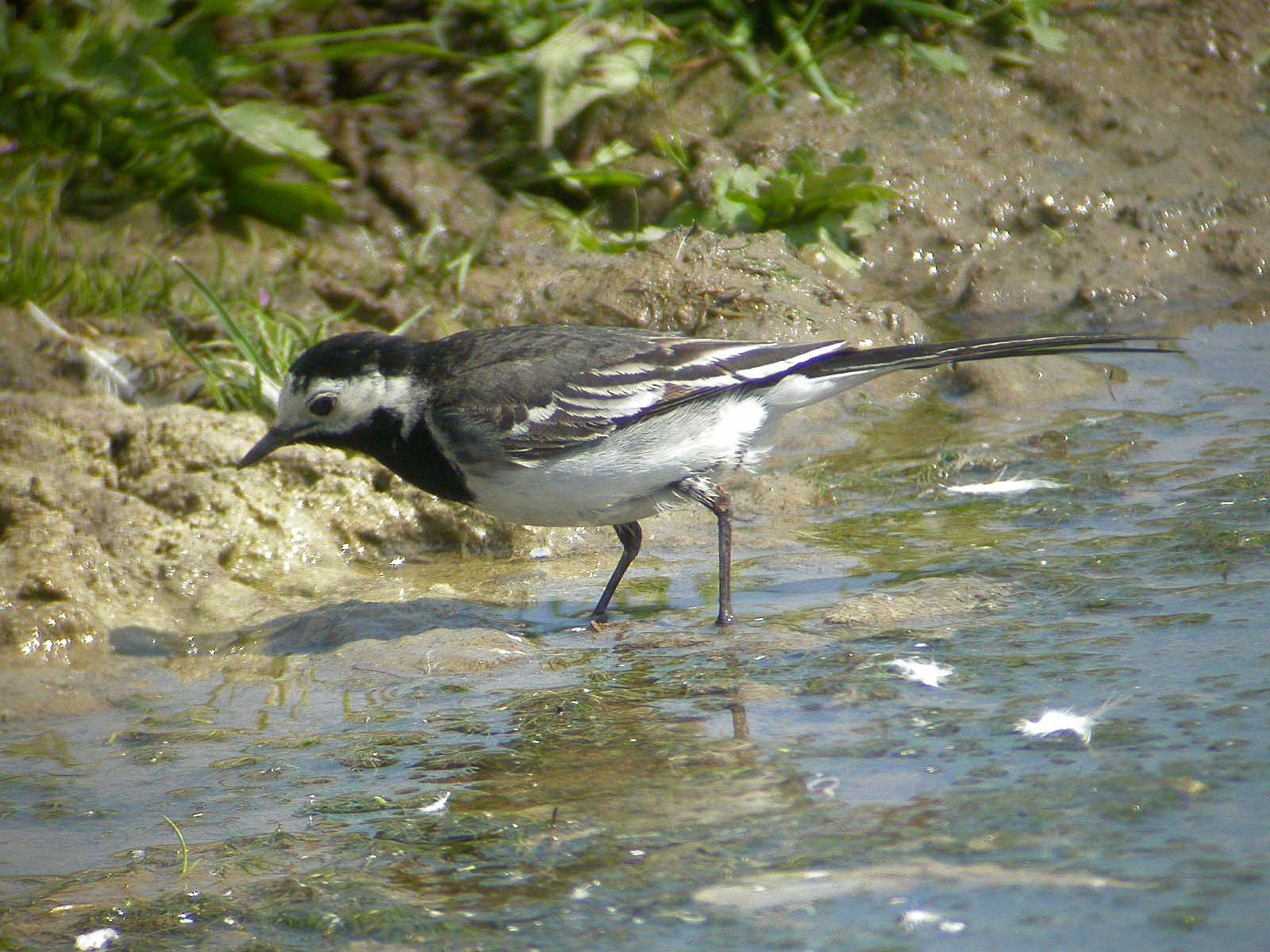
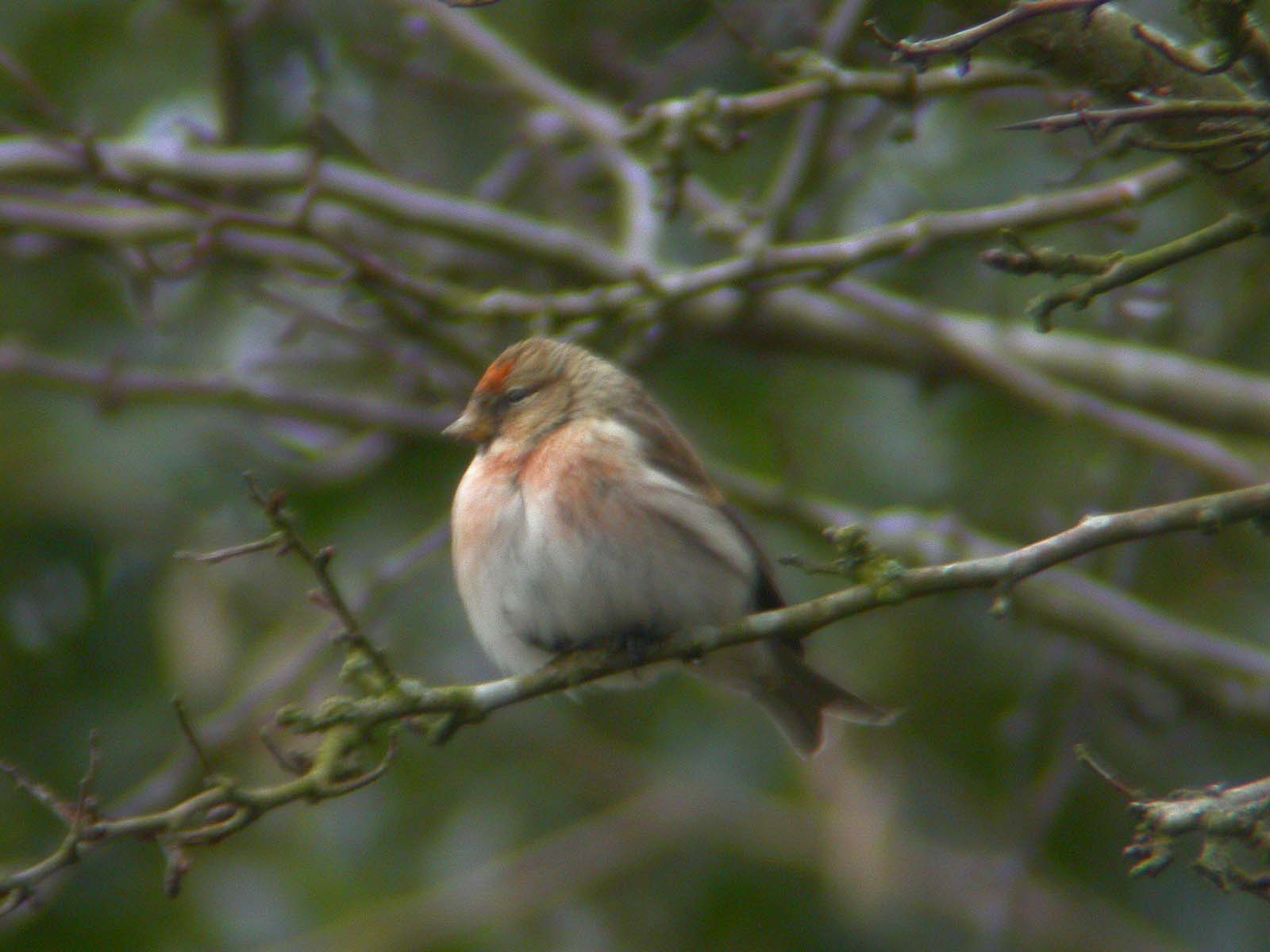
Saturday 3rd March - John Madden
8.00 am. Pink blossom is starting to show on the almond tree in the orchard. As I came down the hill through coldharbour copse I could hear lots of birds calling ahead of me despite the noise of planes overhead. I scanned the fields North of cobham hedge with my binoculars and found a large tree full of starlings and redwings. There must have been quite a few as this tree is nearly twice as high as any of the other hedgerow oaks.
I have noticed that the water forget-me-not leaves in the ponds in my garden are folded over. This is almost certainly great crested newts which lay each egg on a leaf then fold it to hide the egg. Presumably they have also started laying in the reserve ponds. Both great crested and smooth newts were visible on the bottom of the smaller pond just below the dipping platform.
Thursday 1st March - Ray Baker
Went for a little walk around the reserve in the beautiful warm sunshine and noted all of the Celandines which had come into flower alongside the stream that runs down the side of Jenner's field - well, I say 'stream', perhaps 'trickle' would be a better word! Mind you, it's been such a dry spell that it's a wonder that there's any water in it at all. Such a shame, as a decent amount of moving water would be an attractive and interesting addition to the various habitats that we have around the reserve. There are also a few Primroses in the same area, which are always nice to see.
Most notable birds were Dunnocks, which have been singing lustily for a few weeks and they are now very apparent as they squabble for pairings and territory. I have also been noticing the Great Spotted Woodpecker which is often to be seen drumming and flying around in the area of the Community Orchard, favouring the chestnuts and large oaks, as well as the large dead tree on the reserve boundary, which seems to make a particularly satisfying noise when drummed!
Celandine Dunnock
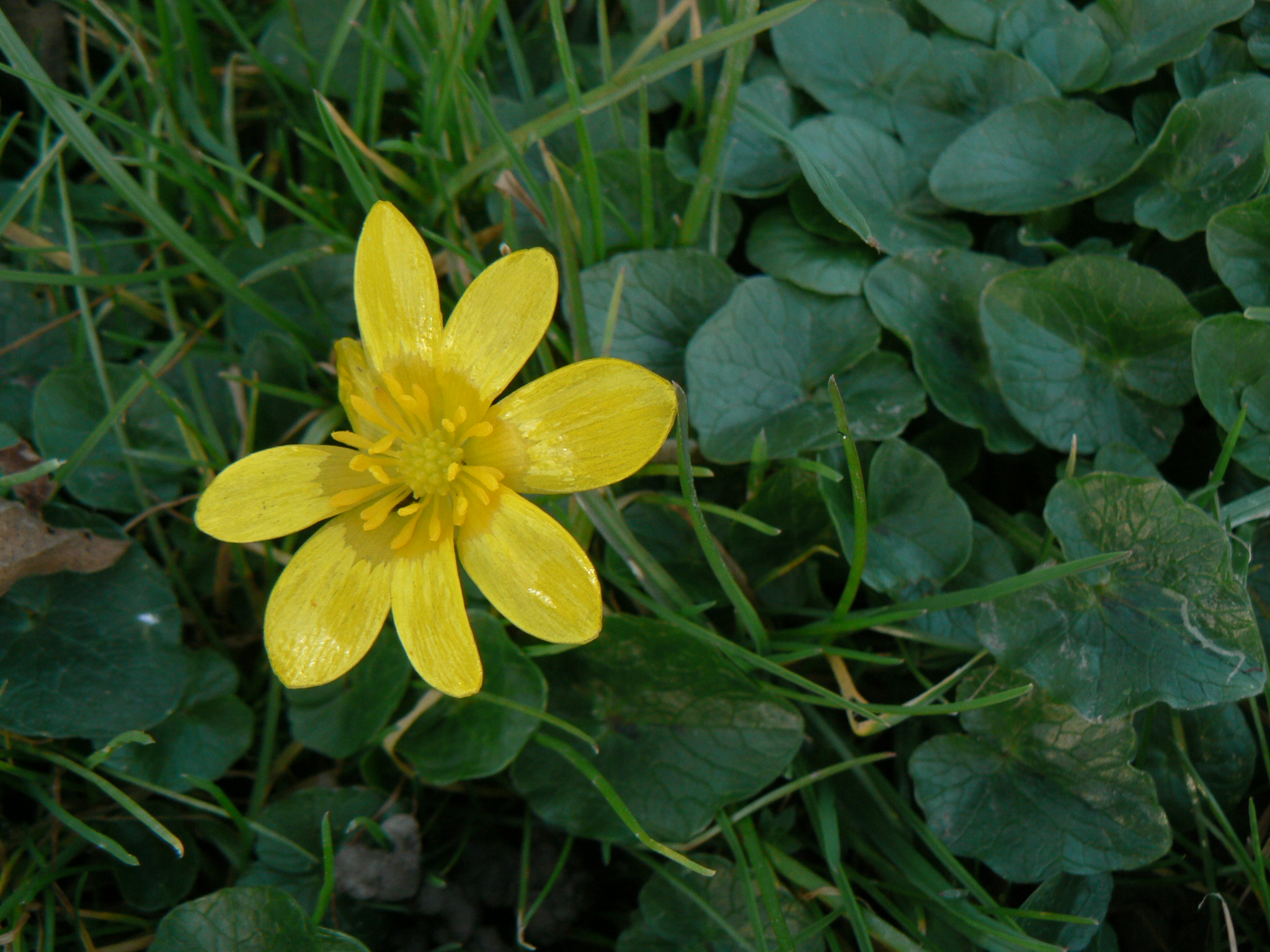
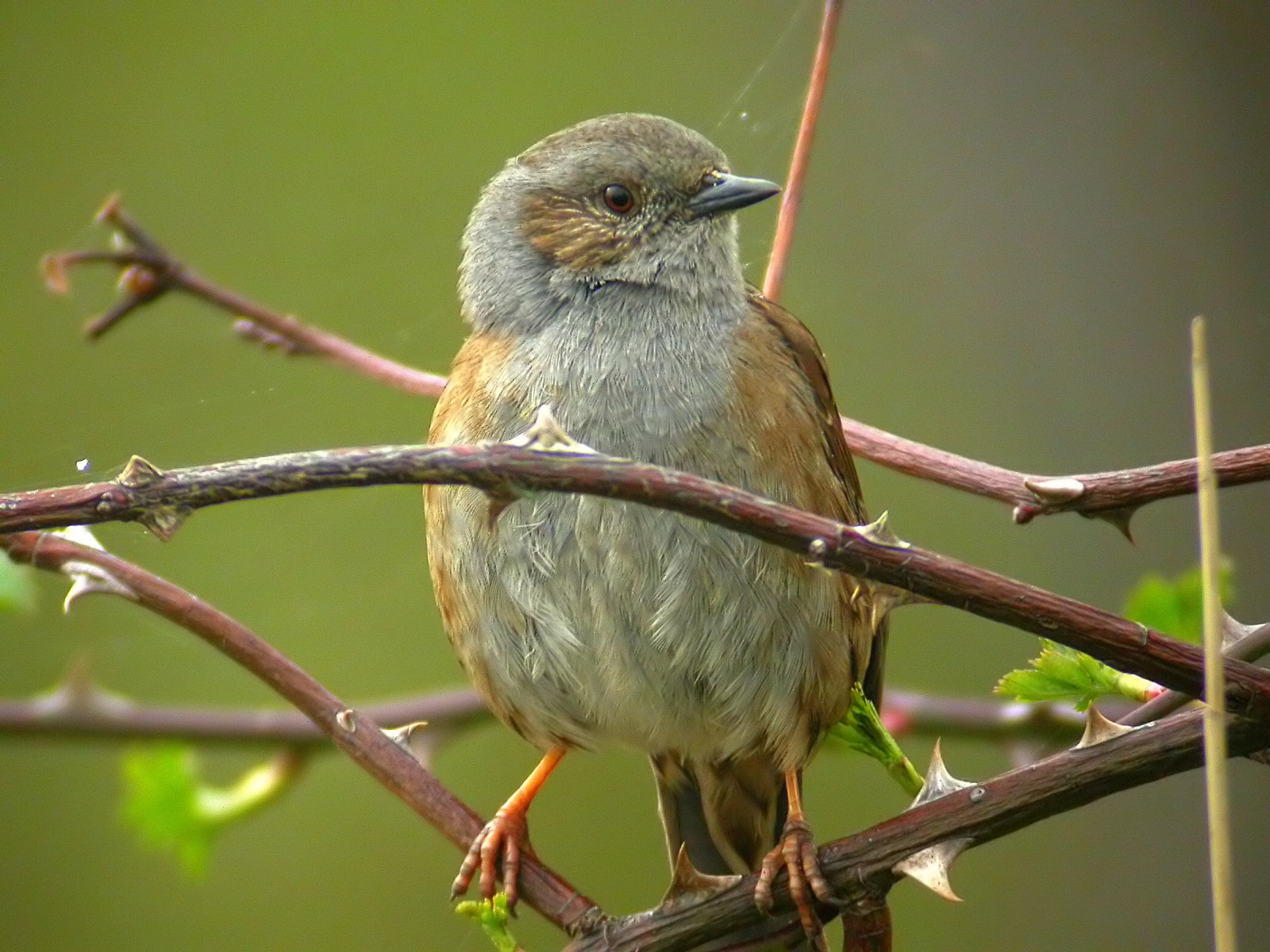
Tuesday 28th February - Ray Baker
A group of us were down in the pond area today building the new stile, and whilst not really fully attentive to the wildlife, couldn't help but notice a few interesting things.
First thing to say was that I was really struck by the number of newts in the larger pond. This is still very muddy following our work last autumn to re-establish a clay-base but obviously the newts don't mind as there were scores of them apparent to even casual observation. This bodes well for the 1st scheduled pond-dipping session in a month's time. There were also a fair number of birds singing with Goldcrest and Blackbird being particularly apparent.
I mentioned the other day about seeing some female/immature Reed Buntings and thought I would include some photographs, as this is one of those species where males and females are very different in appearance - the males are obviously more showy, but I think that the more cryptic plumage of the females is beautiful too.
Female Male
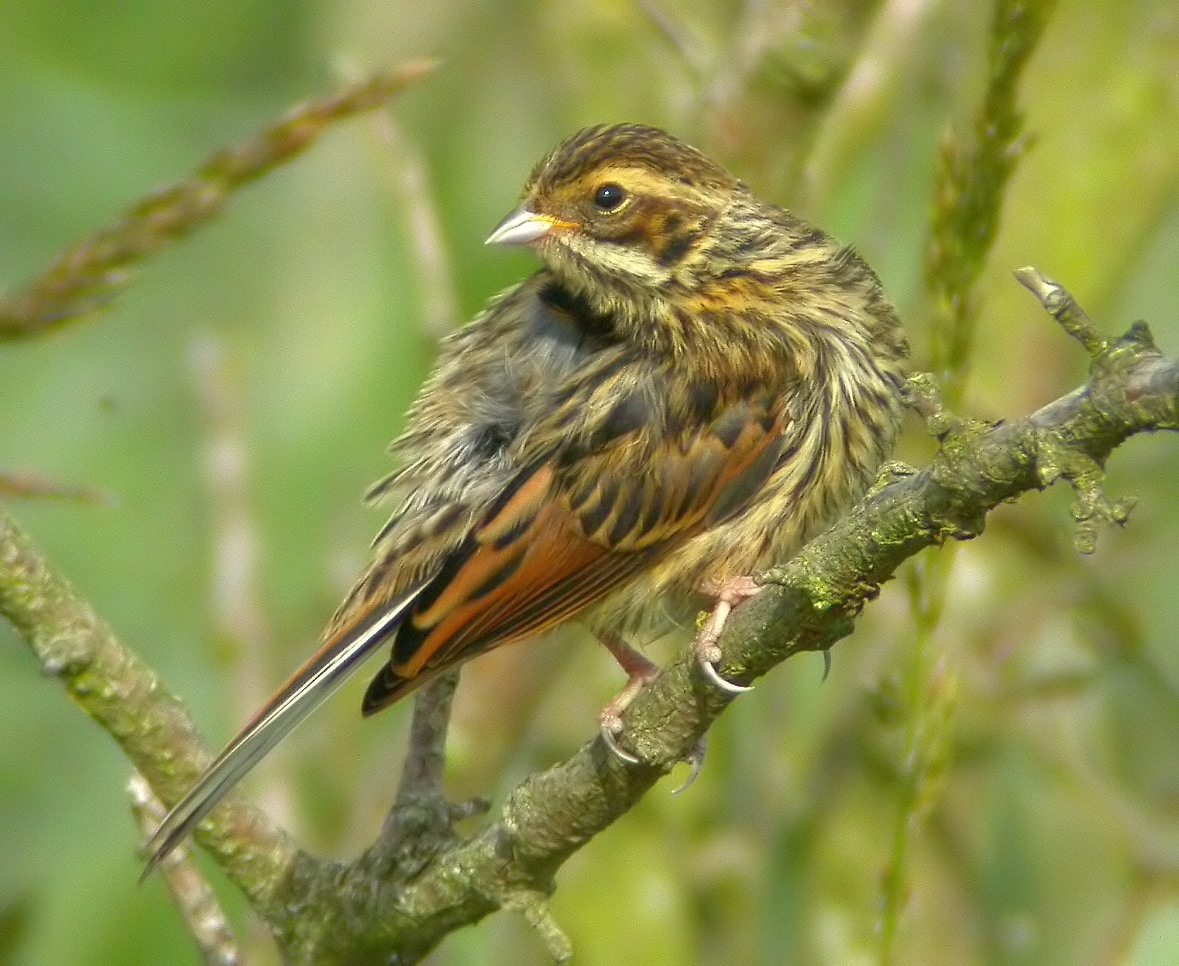
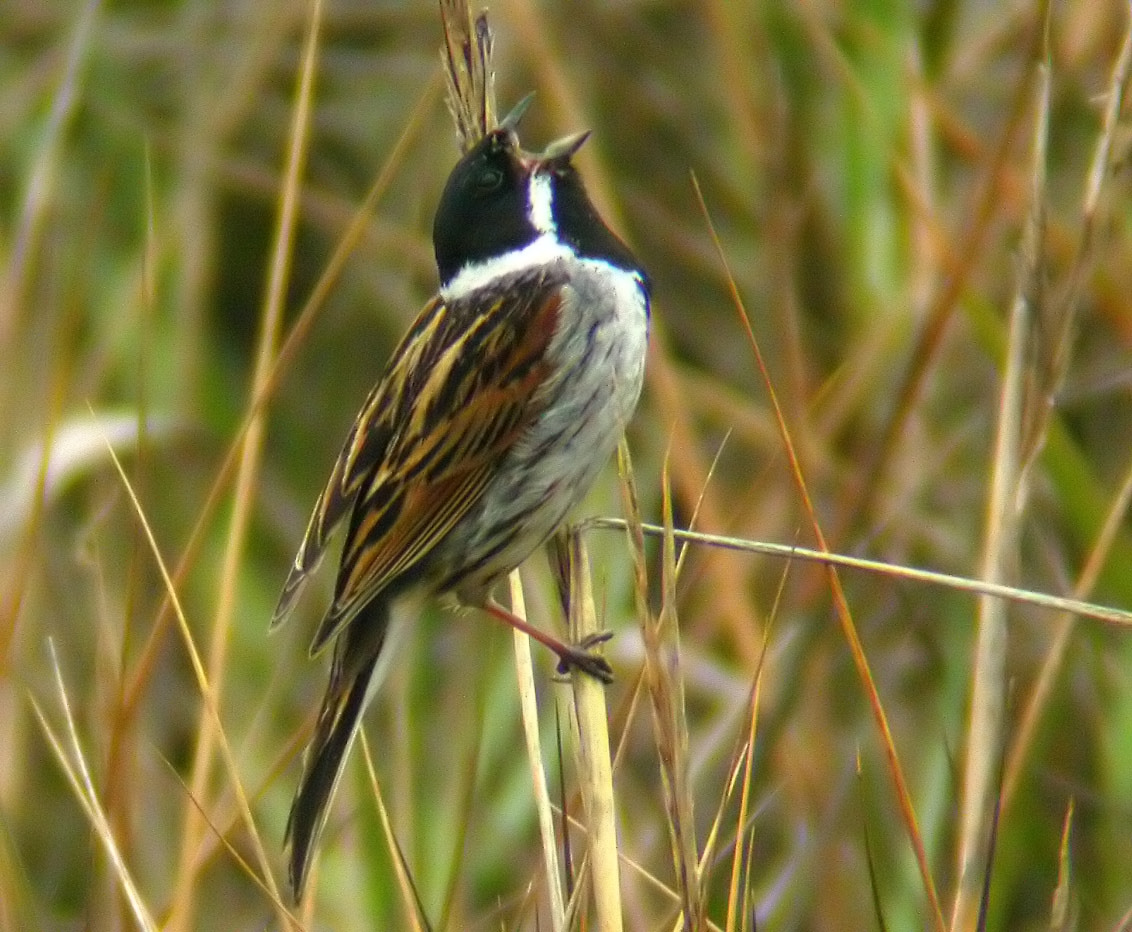
Sunday 26th February - John Madden
5.00pm. Cock yellowhammer singing from the top of a birch tree in Derek Slade Spinney. Also a blackbird singing away in DSS too - the first I have heard this year. Later a second cock yellowhammer singing from a tree in Bloomer's hedge.
Friday 24th February - John Madden
Has warmed up and lots of birds singing. Great spotted woodpecker drumming loudly on one of the chestnuts in the orchard. Pair of pied wagtails in Beacon Field. Redpoll in Alders in Derek Slade Spinney. Great Crested Newts and Smooth Newts in the smaller pond. Magpie, robin, wren, blackbird, chaffinch, greenfinch, crow, collared dove, woodpigeon, house sparrow.
Woodpigeon
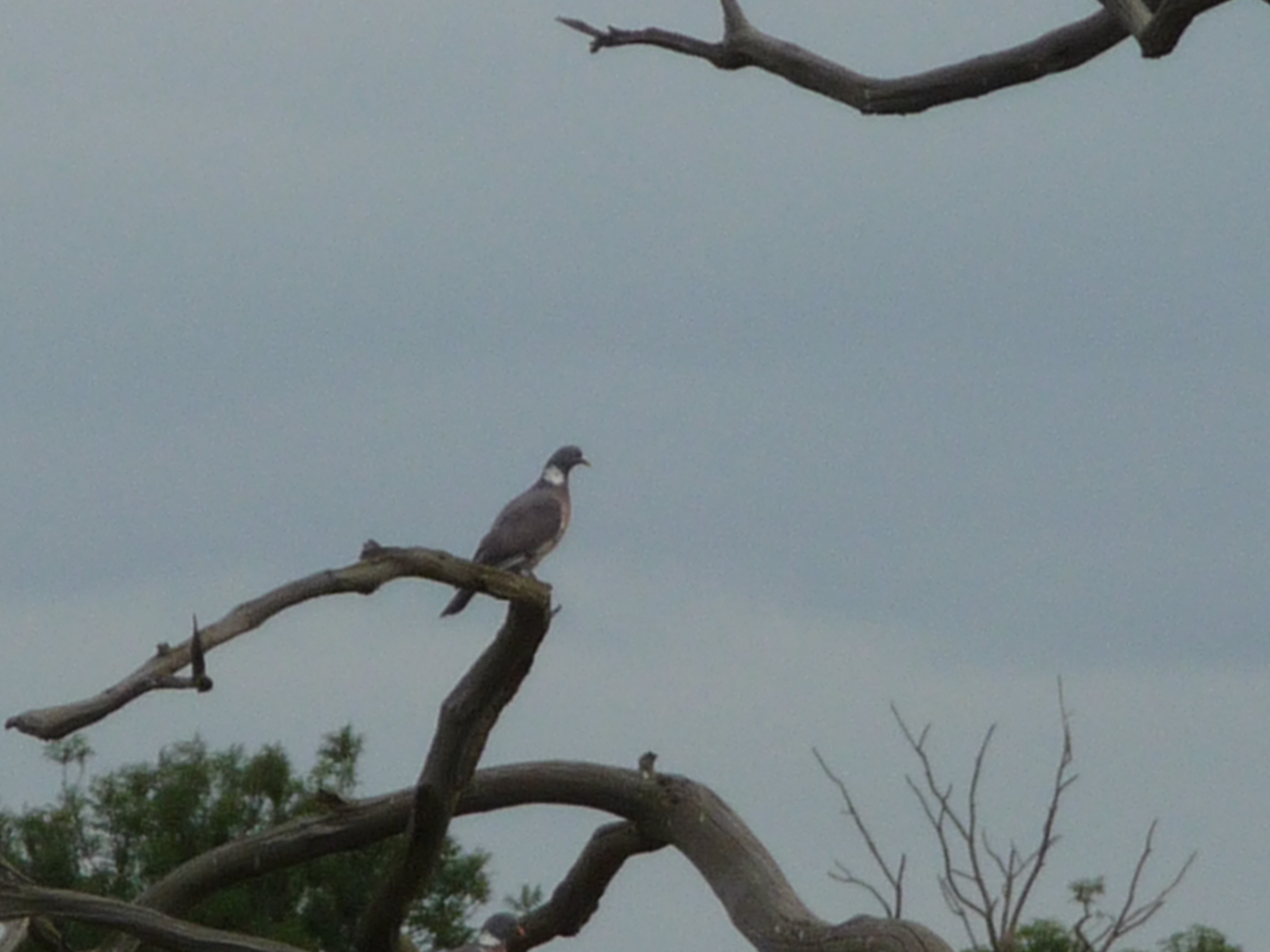
Thursday 23rd February - Ray Baker
Beautiful early-spring day with warm sunshine and quite still conditions, so I thought I would pop down to the pond to check the water-levels and to see if any newts had started to appear yet - they spend much of the year out of water and return to their ponds in early spring to breed. In the event, water-levels are good, with approximately 1m of water depth on the main pond, and the upper pond and new scrapes all doing well too. I was able to see a few Common Newts and one Great Crested Newt. I netted one of each and took some photographs - the photos are pretty poor but you get some idea of the size difference between the 2 species (it's the same jam-jar!) I wonder if it was just coincidence that they were both males, or whether the males return to the water first?
Bird-wise there was a lot of song (as you might expect) and I saw 3 immature/female Reed Buntings and a Siskin together in 'Nightingale Corner' of the wildflower meadow as I walked down (an unusual grouping, I thought) and then 4 Bullfinches in the same bush on the way back. Obviously a popular spot!
Great Crested Newt Smooth Newt
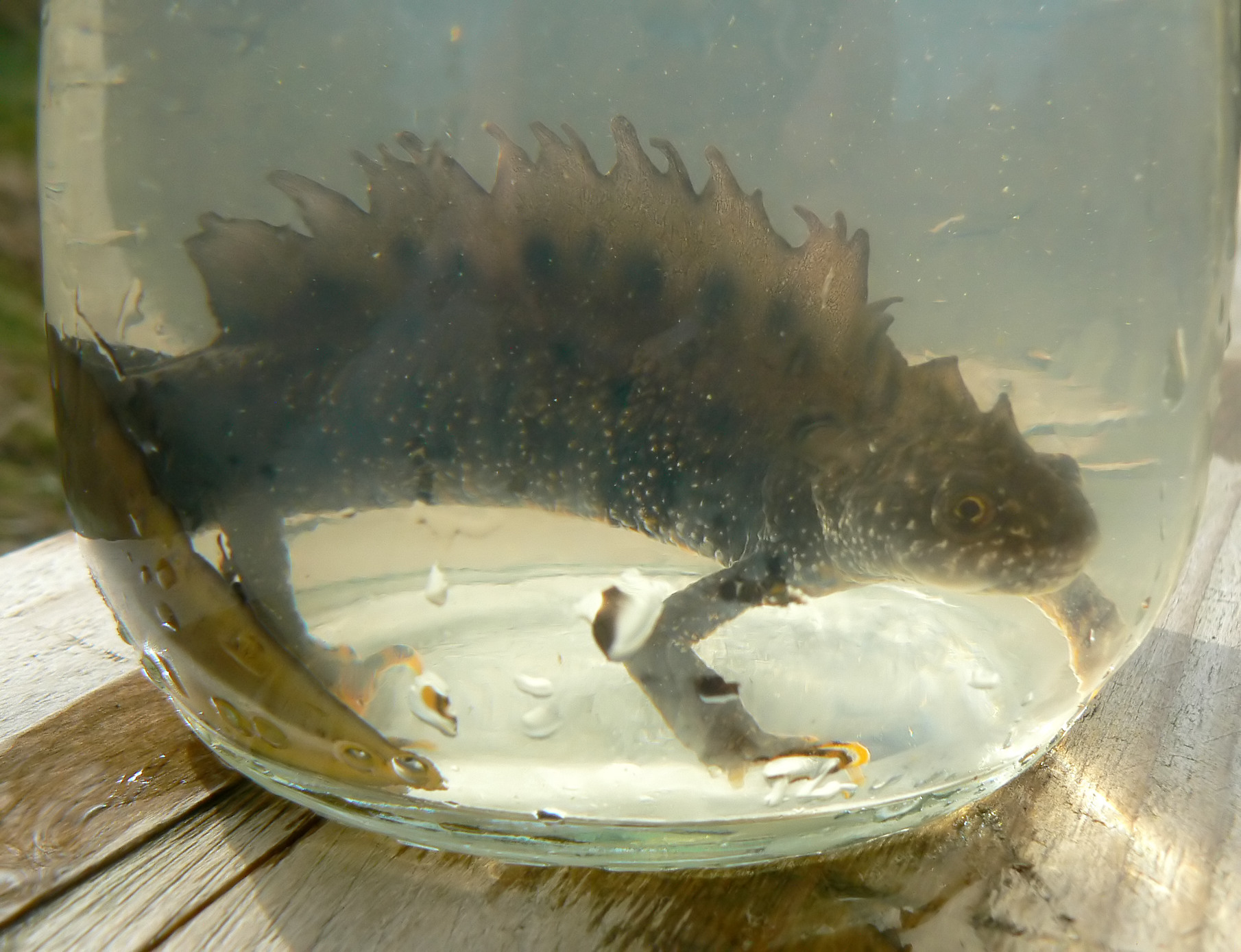
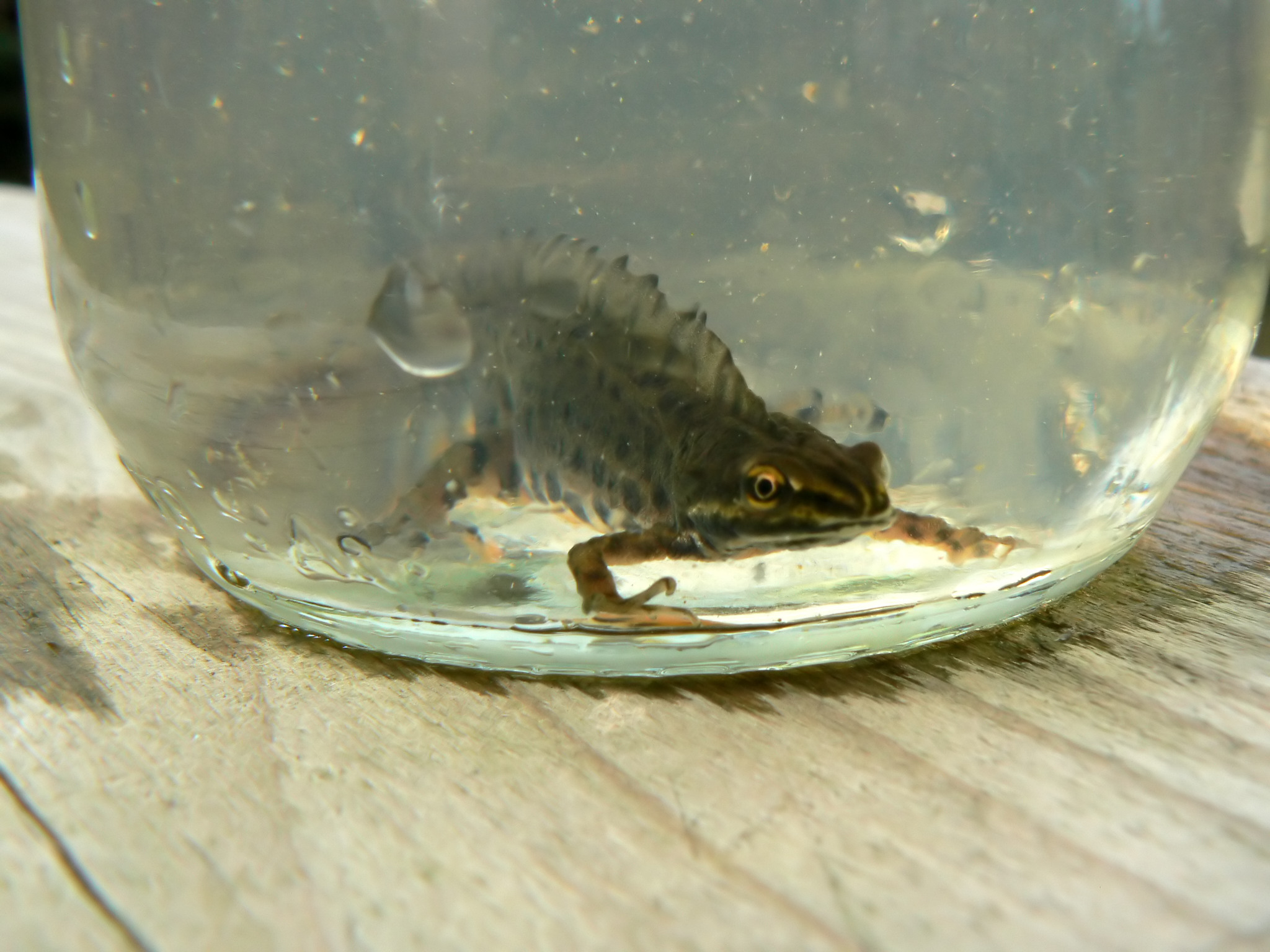
Monday 20th February - Ray Baker
Lots of birds singing in the sunshine today. I've been noticing that Chaffinches have started up with their spring-time 'fast-bowlers' song - this is an accellerating warble (supposed to represent the run-up) finishing with a flourish (supposed to be the ball being bowled!) - it's very distinctive! For such common birds, male chaffinches are surprisingly handsome - note the creamy white wing-patches and tail-sides which flash when in flight, the dusty pink colouration, and the grey 'helmet'. You can't get much more than a hint from my photograph but they also have an olive-green rump, which can be seen when the wings are parted.
As if Chaffinches weren't handsome enough, they also have an even more showy cousin - the Brambling - which is a winter visitor to the UK from mainland northern Europe. Some winters are better than others for seeing this bird (2011/12 has been bad!) but sometimes they can be seen in quite large numbers. A couple of years ago, I saw a flock of 4-5,000 feeding on an un-harvested field in Banstead - just goes to show what a bit of winter food will do!! Brambling has yet to be recorded in the reserve, although I am pretty certain they have visited as I've had them in my garden and I only live 20m outside the reserve boundary. Next time you see a flock of finches, have a good look through - you might be the first to see a Brambling!
Chaffinch Brambling
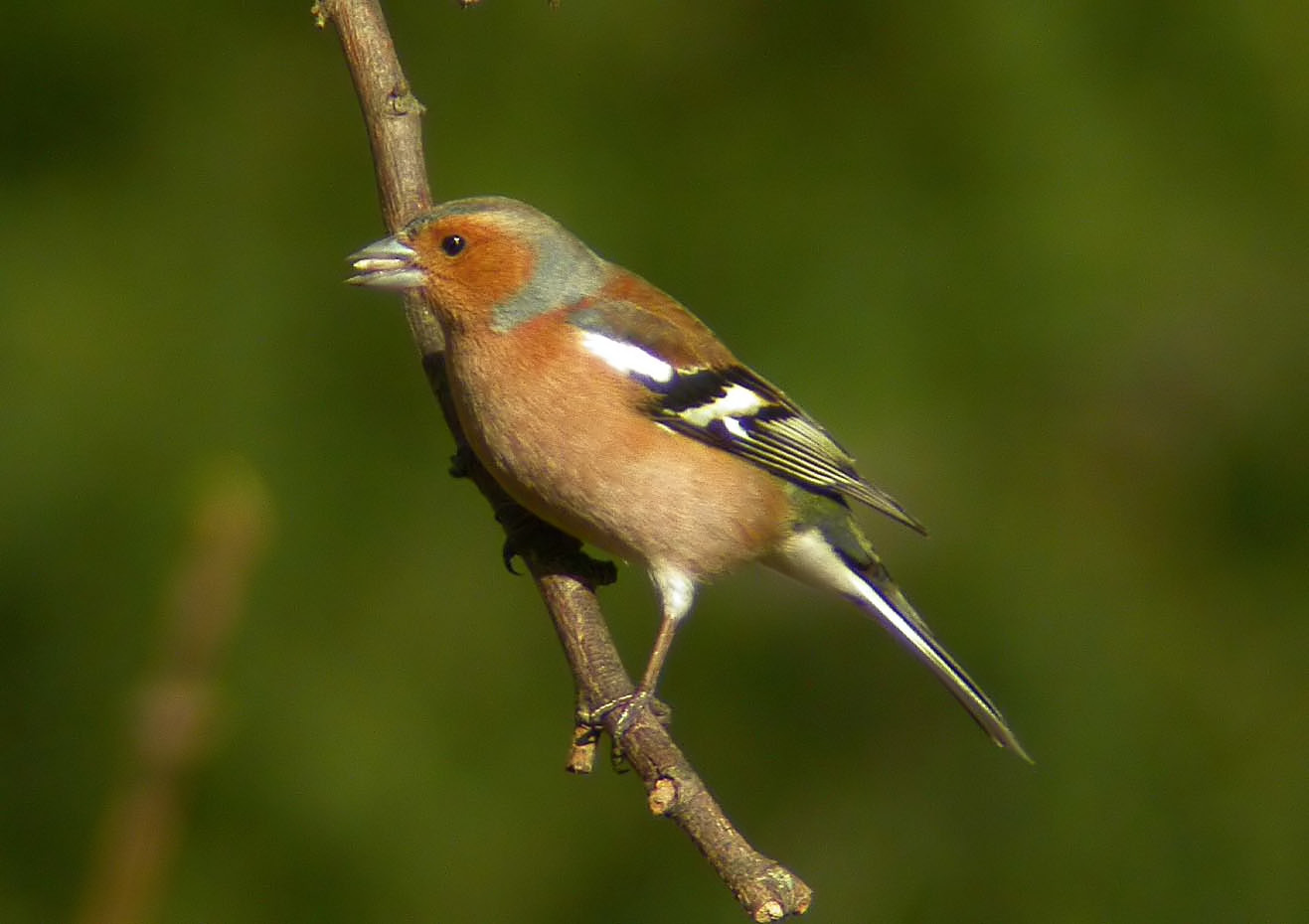
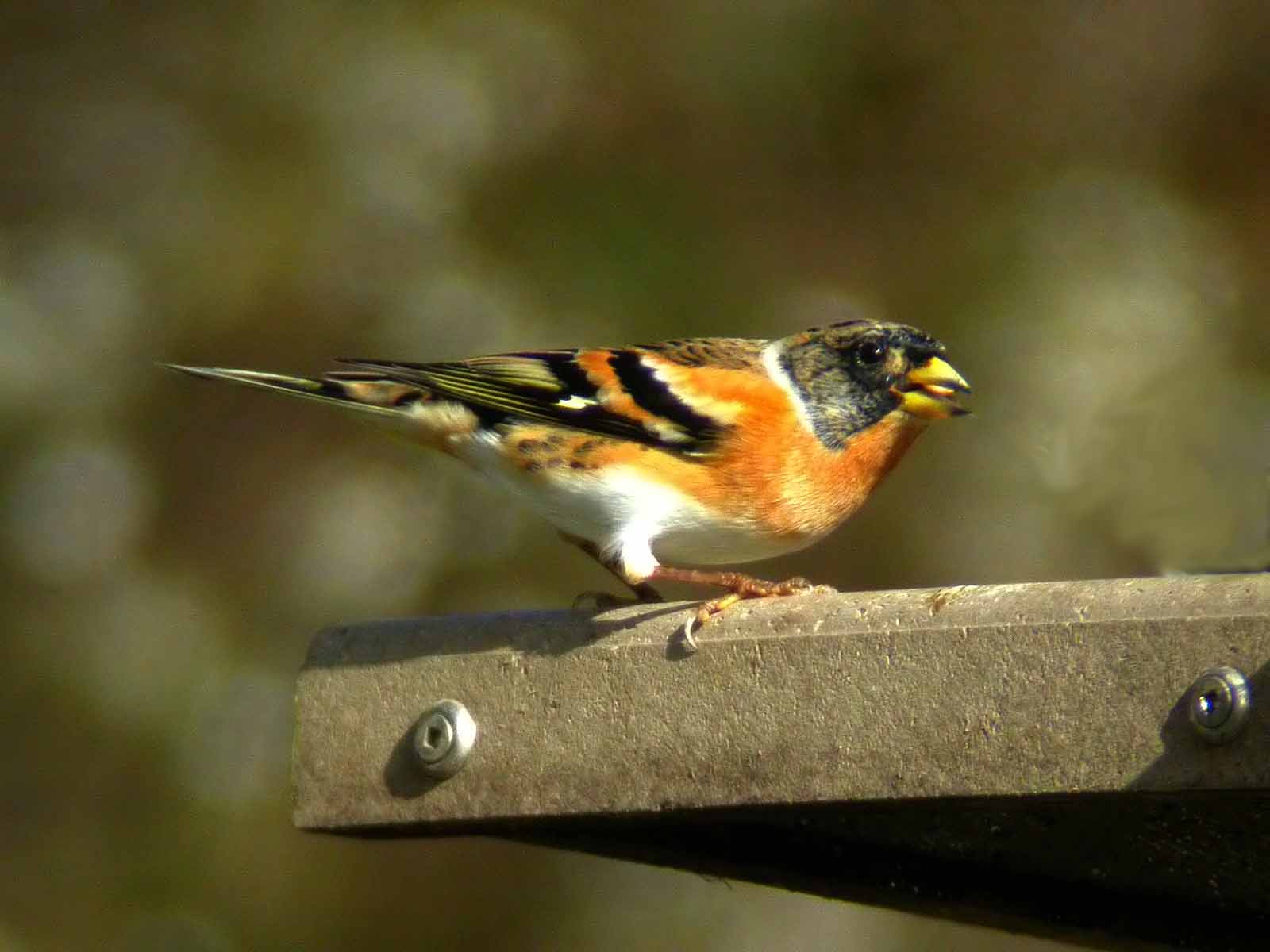
Thursday 16th February 2012 - John Madden
8.00am. Overcast but mild. Cock bullfinch behind scout hut as usual. Pied wagtail. Flock of at least a dozen redpolls in Cobham Hedge then Coldharbour Copse. Redwings in Cobham Hedge. Greenfinch. Green woodpecker yaffling. Woodpigeon. Lots of great tits and blue tits often in small groups. Cock blackbirds fighting by the ponds. Song thrushes. Chaffinches singing. Herring gulls over. Goldfinches feeding on alder cones in Derek Slade Spinney. House sparrows. Starlings.
Tuesday 14th February - Ray Baker
Bird-wise, many of the usual suspects were in evidence over the reserve this morning, with Bullfinches and particularly Redpoll amongst the better species seen. Most interesting sighting though was probably a Grey Heron which flew low and slow over the reserve, and may well have called in at the pond had it not been seen off by the local crows. Herons are voracious eaters - not only will they decimate your prize Koi on a slow afternoon, but over the years I have seen them take fish of all shapes and sizes, a rabbit, a Coot and a very large eel. "What's unusual about eating an eel?" I hear you say.... Well on this occasion, the eel was very large and had to be eaten 4 times before it finally gave up the ghost - the previous 3 times it disappeared completely, only to reverse back out again a few minutes later. It was only after its head was brought into repeated and violent contact with a large rock that it eventually gave up and became dinner!!
Grey Heron Redpoll
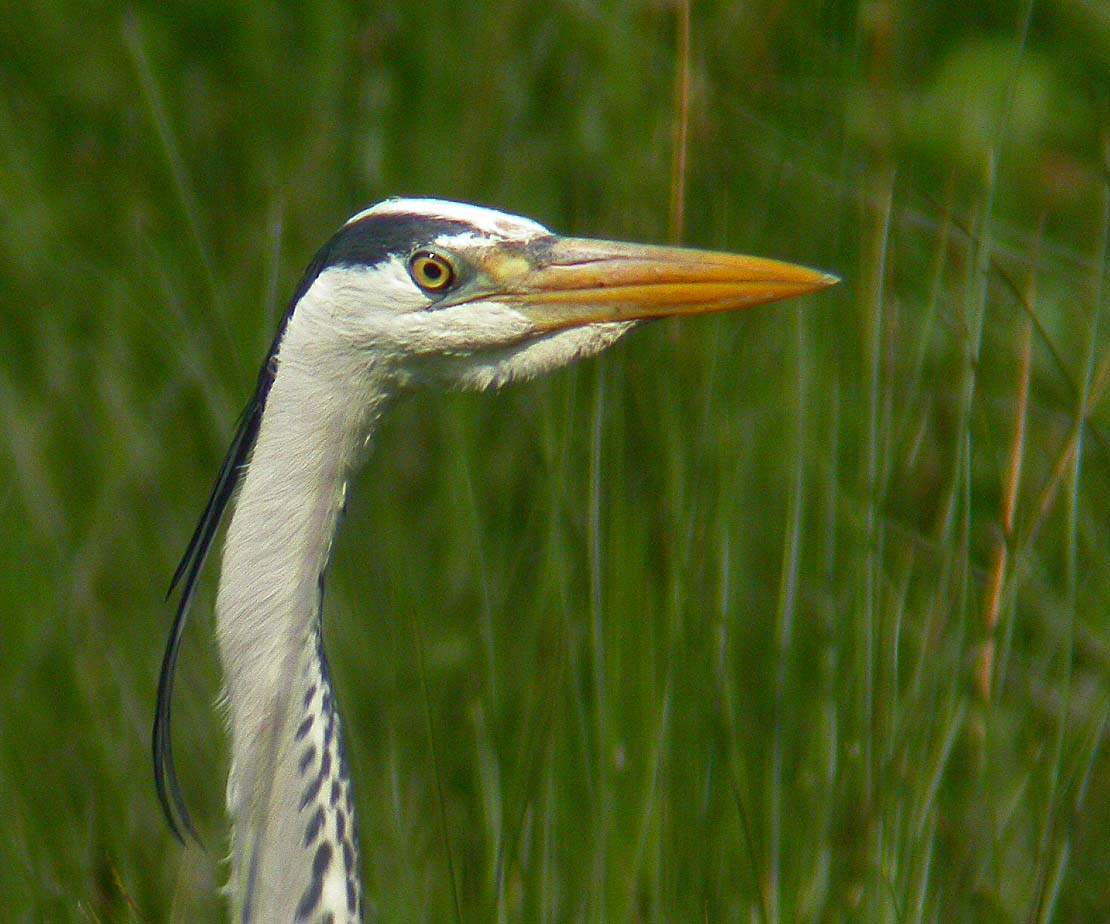
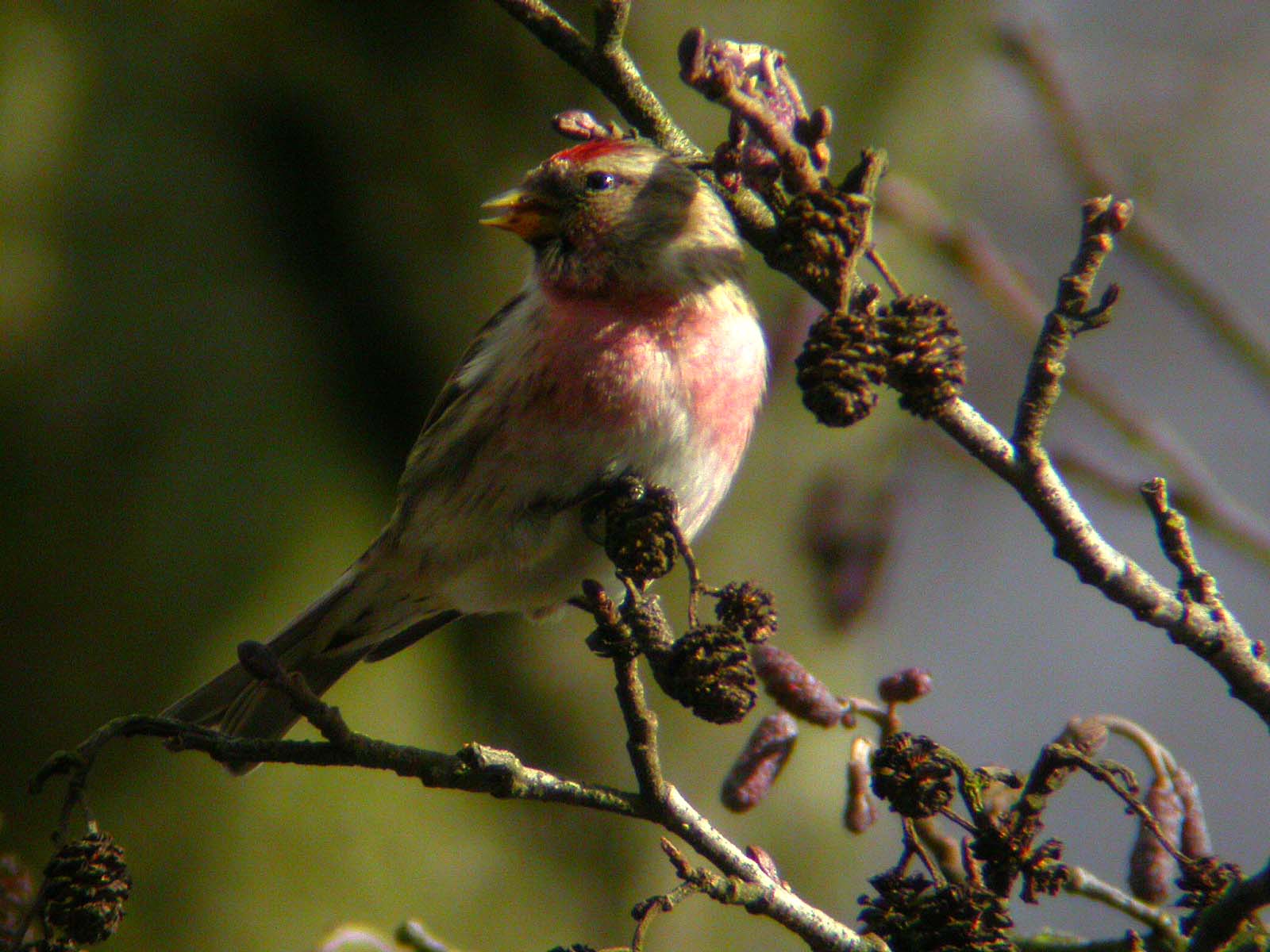
Saturday 11th February 2012 - John Madden 8.30am
Reserves are bathed in beautiful Winter sunshine. Birds are everywhere although binoculars are needed. Alder and hazel catkins are lengthening. The only berries left in any numbers are guelder rose. Maybe they are the least nutritious and are eaten last. They are being eaten by blackbirds, fieldfares and bullfinches in the bushes around the ponds although the bullfinches are probably after the seeds inside. Chaffinches are singing. Magpie inspecting a nest by the scout hut. Goldfinches in Bloomers Hedge. Bullfinches by ponds and in orchard. A dozen redpolls feeding on the ground on the Eastern side of Coldharbour Copse. Greenfinches. Robins chasing each other. Dunnocks singing high in the trees. Song thrush. Blue and great tits everywhere often in pairs. Lots of wood pigeons. Jay. Carrion crow. Greater spotted woodpecker drumming. Starlings.
Friday 10th February - Ray Baker
I popped over to the reserve this morning to burn up some hedge-trimmings from the pond area and I was struck by the amount of birdsong in the air. It was pretty cold and snowy, but it only takes a little bit of sunshine at this time of the year to set the birds off, and Blackbirds, Robins, Dunnocks, Greenfinches, Great Tits and Collared Doves (but no Song Thrushes, interestingly enough!) were all singing away lustily.
If you are interested in seeing the birds then the pond area isn't a bad place to look, as some of our better species favour the alders and birches in Derek Slade spinney and today, in addition to the seemingly ubiquitous Bullfinches feeding on the berries around the pond, there was a mixed flock of Goldfinches, Siskins and Redpolls feeding there. Despite all being quite colourful species, these can be surprisingly hard to see as they feed amongst the tree branches - luckily they have the habit of chattering away with their contact calls, which is often the first sign of their presence.
Goldfinch Siskin

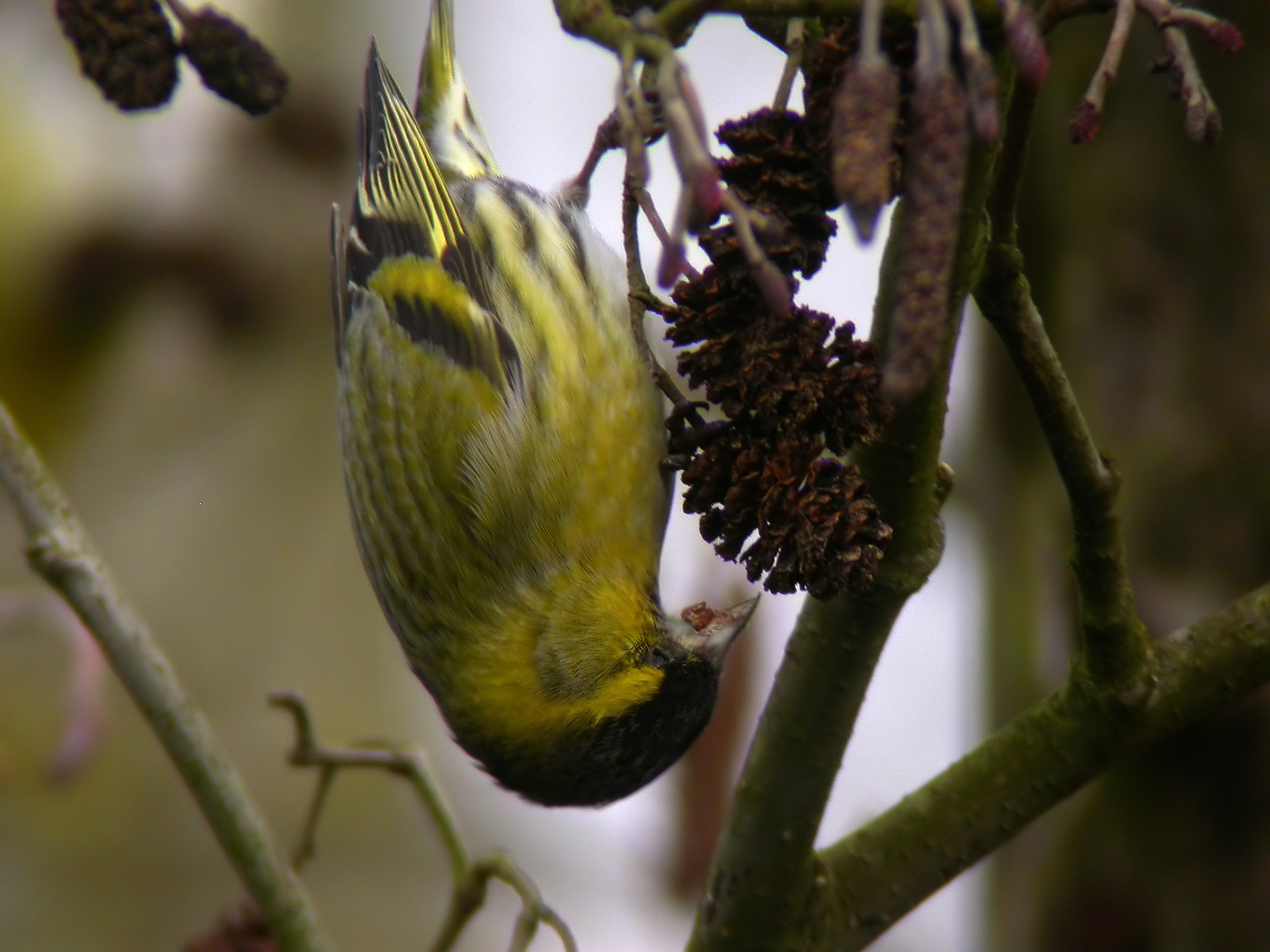
Sunday 5th February - Ray Baker.
Overnight snowfall had transformed the reserve into a winter wonderland with many local residents out enjoying the day. Most notable birds seen were Fieldfares, with several feeding in the reserve and many more flying over in small groups, often given away by their chuckling cries. Also of note were a number of Bullfinches with 2 feeding on the ground by the information board in the community orchard and another one feeding on the rapidly diminishing stock of berries down by the pond. Song Thrushes continue to be very apparent, mainly announced by their wonderful song, and it is good to hear several Greenfinches singing in the area, as these birds are not as common as they were a few years ago.
Fieldfare Bullfinch
